














Architecture. Landscape architecture. Interior design. Our professionals work side-by-side to create fully integrated, client-centered design solutions that transform each project vision into reality.

Tracy Barbour

Alexandra Kay








First National understands the unique challenges of doing business in Alaska. Facing tight deadlines and remote locations, you need a bank that moves as quickly as you do — one that is responsive, reliable, and able to make decisions locally. Let’s work together to build Alaska’s future, one project at a time.



















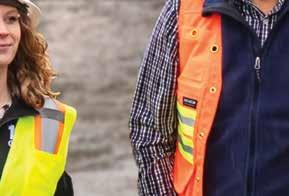


Explore how Drake Construction and First National Bank Alaska work together to build Alaska one community at a time.




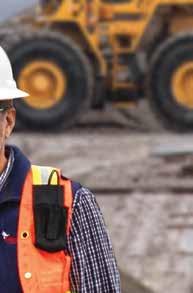







40 OUTSIDE SPEAKS TO INSIDE
Beneath the surface of interior design
By Scott Rhode
46 BIG SOLUTIONS IN SMALL PACKAGES
How Petersburg is tackling its housing shortage
By Katie Pesznecker
76 BLUEPRINTS FOR THE GOLDEN HEART
Multidisciplinary firm Design Alaska
By Vanessa Orr
52 MAKE IT RAIN
Fire prevention and protection for building safety
By Rachael Kvapil
56 3D PRINTED HOMES
Automated construction with advanced materials
By Vanessa Orr

66 SPARKING IDEAS, DELEGATING DETAILS
AI is proving useful for small businesses
By Rindi White
72 WINNING THE WORK
Meet the Society for Marketing Professional Services
By Amy Newman
60 2024 ANCHORAGE ENGINEER OF THE YEAR NOMINEES

Look up at Loussac Library and notice the texture of the ceiling in the bridge connecting its fortress-like turrets. Loussac Library, designed by Environmental Concerns, Inc. of Spokane, Washington, is the second building to carry the name of that former Anchorage mayor. The first, funded by Z.J. Loussac’s philanthropic efforts, was built in the ‘50s in a prime position in Downtown Anchorage along Fifth Avenue.
In the ‘70s, the city grew (and merged with its surrounding borough), and another mayor pushed for public investments worthy of the burgeoning metropolis. George M. Sullivan was the driving force behind Project 80s, a slate of state-funded construction projects. Those buildings included the new Loussac Library, the Egan Civic & Convention Center on the site of the previous library, the Alaska Center for the Performing Arts across the street, and the multipurpose arena named in Sullivan’s honor.
On the occasion of this magazine’s 40th anniversary, this month’s article “Anchorage’s Aspirations” checks in with those physical manifestations of that decade’s civic spirit.
Cover by Monica Sterchi-Lowman

So me years ago, my father and I watched The Red Green Show perform at the Alaska Center for the Performing Arts (PAC). It was a delightful show, largely because my father and I both enjoy Red Green’s humor, but I also remember how the audience members themselves added to the evening’s atmosphere. Dad and I noticed, as we sat in the auditorium waiting for the production to begin, that there were two types of attendees. About half of the audience wore a combination of flannel shirts and jeans; the other half sported suits and evening gowns. Did someone miss the memo on the dress code?
Absolutely not. One of the great joys of the PAC is its function as a community hub, and in Alaska, that community includes those who dress for comfort and those who are looking for an excuse to wear elbow-length gloves. I remember attendees chatting politely before the show began, no one paying much attention if their partner in conversation was sporting a tie or work boots.
Growing up in an Anchorage that boasted such a community venue, I didn’t give much thought to whether or not my hometown’s population justified a performing arts space with multiple auditoriums. As an adult, I’m grateful that forty years ago the Anchorage community, awash with funds derived from North Slope oil and gas production, chose to invest in the city and its future. In an interview for this issue’s cover story, Codie Costello, president and chief operating officer for the PAC, said, “We’d be a very different place without these community venues… I think it’s important to acknowledge that gift. I think it’s important for us to reimagine how we invest in and maintain those gifts.”
The spaces in which we spend time influence us long after we’ve left them. Designing community buildings and spaces to be safe, functional, comfortable, and welcoming isn’t a nicety, it’s a necessity. Alaska’s architects and engineers excel at crafting places that can be filled with art, music, conventions, and commerce, creating moments that turn Anchorage residents into neighbors and friends. Such venues gather Alaskans in denim and flannel with those in silk and beads to learn, grow, and laugh.


Tasha Anderson Managing Editor, Alaska Business
EDITORIAL
Managing Editor
Tasha Anderson 907-257-2907
tanderson@akbizmag.com
Editor/Staff Writer
Scott Rhode srhode@akbizmag.com
Associate Editor
Rindi White rindi@akbizmag.com
Editorial Assistant
Emily Olsen emily@akbizmag.com
Art Director
Monica Sterchi-Lowman
907-257-2916
design@akbizmag.com
Design & Art Production
Fulvia Caldei Lowe production@akbizmag.com
Web Manager
Patricia Morales patricia@akbizmag.com
VP Sales & Marketing
Charles Bell 907-257-2909
cbell@akbizmag.com
Senior Account Manager
Janis J. Plume 907-257-2917
janis@akbizmag.com
Senior Account Manager
Christine Merki 907-257-2911
cmerki@akbizmag.com
Marketing Assistant
Tiffany Whited 907-257-2910
tiffany@akbizmag.com
President
Billie Martin
VP & General Manager
Jason Martin
907-257-2905
jason@akbizmag.com
Accounting Manager
James Barnhill 907-257-2901
accounts@akbizmag.com
Press releases: press@akbizmag.com
Postmaster: Send address changes to Alaska Business 501 W. Northern Lights Blvd. #100 Anchorage, AK 99503
By Tracy Barbour
Co mmunity development
financial institutions (CDFIs) share a distinct mission: to expand economic opportunities in communities traditionally overlooked by banking and investing services. There are approximately 1,000 certified CDFIs in the United States, and 8 of them operate in Alaska.
The CDFIs in Alaska are Alaska Growth Capital (AGC), Alaska Benteh Capital, Cook Inlet Lending Center (CILC), Haa Yaḵaawu Financial Corporation, NeighborWorks Alaska, HomeOwnership Center, Spruce Root, and Tongass Federal Credit Union (TFCU). These mission-driven, private-sector entities often work together to serve low- and middleincome individuals in urban and rural areas. They promote selfsufficiency, economic growth, and community redevelopment.
Meet the Institutions
TFCU—Alaska’s only depository CDFI—focuses on improving the lives of individuals and organizations
throughout Southeast by offering innovative financial services and education. “By supporting small businesses and nonprofits through loans, technical assistance, and partnerships—like our work with Native CDFI Spruce Root—we help foster economic growth,” says President and CEO Helen Mickel.
“Financial literacy is also a key focus, as we equip our members with the knowledge to make informed financial decisions.”
With its “people-helping-people” philosophy, TFCU works to be a part of each community it serves.
the resources they need to thrive,” Mickel says.
At CILC, the primary goals are to improve the financial knowledge and wellness of its communities; expand its outreach, products, and services to serve more people; and diversify its funding sources for greater sustainability and opportunities.
“As a Native CDFI, CILC vigorously pursues opportunities to financially empower Alaska Native families, businesses, and communities,” says President and CEO Jeff Tickle.

“We wear that CDFI banner with commitment to community development in any way we can support and build on it. Our CDFI certification allows us to cultivate communities where everyone has access to opportunity, respect, and
CILC offers a variety of financial products and services to underserved populations, including down payment assistance loans, primary mortgage loans, and down payment assistance grants (Home$tart and Native American Homeowner Initiative) as a member of Federal Home Loan Bank of Des Moines. It also provides micro and small business loans and credit lines, as well as financial wellness services. For 2025, CILC plans to launch a credit builder loan product.
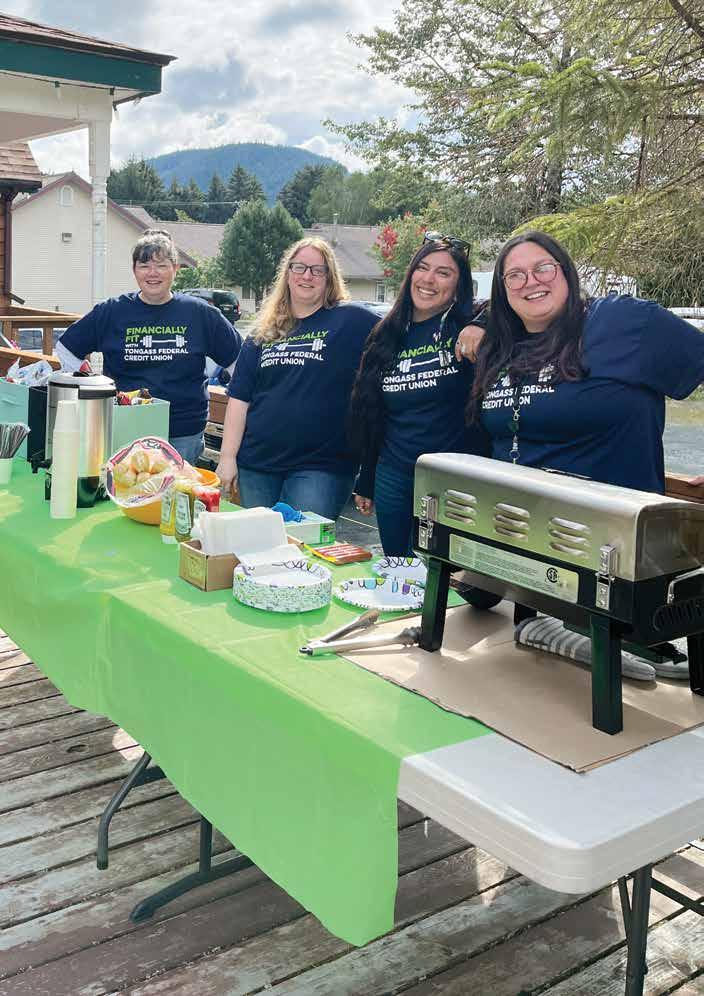


AGC is also a Native CDFI, founded by Arctic Slope Regional Corporation in 1997 as the state’s first Business and Industrial Development Corporation. McKinley Management acquired AGC in 2022 with Bristol Bay Native Corporation. As of 2025, McKinley became the minority partner while Bristol Bay Native Corporation took majority control.
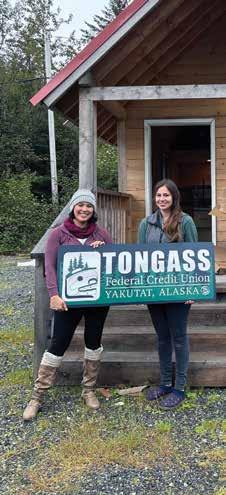
generations. “We are a driver of a regenerative economy across Southeast Alaska, so communities can forge futures grounded in this uniquely Indigenous place,” says Executive Director Alana Peterson.
AGC’s niche and expertise is lending in rural areas and to Native-owned businesses. “Our goal is really to help get our clients to a ‘yes’ on their loan when they have not been able to successfully access financing elsewhere,” says Mary Miner, vice president of community development.
AGC primarily provides Small Business Administration 7(a), US Department of Agriculture, and Business and Industry Guaranteed loans. With its average loan being about $1 million, AGC lends in the range of $250,000 to $10 million. “Our structure and utilizing government guarantees allows us to be more flexible than other lenders,” Miner says.

AGC, whose portfolio is just under $100 million, has a loan volume of $17 million to $25 million annually. It provides financing for diverse industries, ranging from transportation to hospitality to tourism. AGC also offers technical training and community education.
Spruce Root has a unique vision: to amplify its Haida, Tlingit, and Tsimshian ancestral imperative to ensure Southeast thrives for future
Spruce Root offers Fast Start Loans—zero-collateral financing up to $50,000 for qualifying borrowers— and standard business loans up to $500,000. Since its inception in 2012, it has deployed more than $4 million in lending capital to establish small businesses in Alaska. “In 2023 alone, ten loans totaling $850,000 were deployed across seven Southeast Alaska communities,” Peterson says.
Although the term “CDFI” is relatively new, the concept extends back to the 1930s with AfricanAmerican communities forming
the first credit unions and even earlier to the 1800s with immigrant guilds in New York City’s Lower East Side. In 1994, Congress extended CDFIs nationwide when the Riegle Community Development and Regulatory Improvement Act establ ished the CDFI Fund.
Managed by the US Treasury Department, the CDFI Fund offers certification to CDFIs, which allows them to apply for financial and technical assistance awards. For example, grant funds enabled TFCU to establish local services in remote villages through co mmunity microsites.
“The funds have also allowed us to provide affordable lending to low- to moderate-income borrowers with less-thanperfect credit,” Mickel says. “Our financial education initiatives have also been supported throug h funding received.”
During the COVID-19 pandemic, federal funding had a significant impact on CILC. It was able to partner with the Municipality of Anchorage to administer grants to small businesses, nonprofits, and artists totaling mo re than $30 million.
The CDFI Fund also has the New Markets Tax Credits Program. Begun in 2002, it encourages privatesector investment by offering tax credits for qualified community development investments. In Alaska, AGC is the only entity that receives those credits, according to Miner.
The Native Initiatives CDFI Program provides further capital. “The CDFI fund is our largest supporter, and we are grateful for all the resources that it provides,” Miner says.
There are six basic types of CDFIs: community development
“All
of our loan officers here came from the conventional banks in
deep
Alaska, so they have
connections with those lenders… It takes a village to help move some of these big initiatives forward and to help small businesses.”
Mary Miner, Vice President of Community Development, A laska Growth Capital
• Bill Pay to automate regular payments
• Merchant Services to accept debit or credit cards
• Positive Pay to help prevent check fraud
• Business Remote Deposit to save you time
Call 877-646-6670 or visit globalcu.org/business to talk to a specialist today!

The
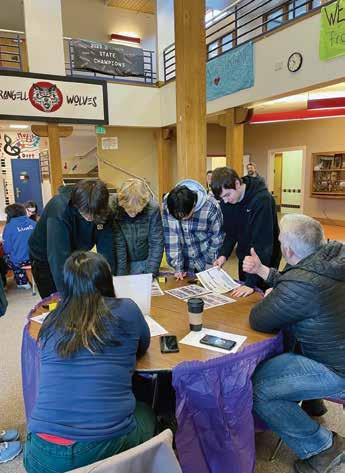
banks, community development loan funds, community development credit unions, microenterprise funds, community development corporation-based lenders and investors, and community development venture funds. CDFIs do not replace conventional financial institutions; th ey complement them.
Partnerships are vital to the success of CDFIs. “For example, the Kake Tribal Corporation and the Hoonah Indian Association have provided space for our community microsites, allowing us to bring essential financial services to remote areas,” Mickel explains. “We also partner with schools and community organizations to deliver financial literacy programs, ensuring that individuals and families have

the knowledge to make sound financial decisions.”
Spruce Root has partnered with local banks to spread the word that a “no” on traditional financing does not have to mean the end of a small business owner's journey to financing. Peterson adds, “We have worked very hard to build relationships with municipalities, tribes, nonprofits, and other nontraditional lenders to find the entrepreneurs that are seeking support and to make sure that we are giving them the option that is best for their business—whether or not t hat is Spruce Root.”

have a very strategic partnership with the Anchorage Community Land Trust (ACLT) and Cook Inlet Tribal Council around ACLT’s initiative of an Indigenous Peoples Set Up Shop program, in which ACLT provides business training and assistance and CILC provides lending services and capital,” Tickle says. “This partnership with ACLT is a primary reason Cook Inlet Lending now has a Small Busine ss Lending program.”
CILC is part of a small business scaffold in the Anchorage area. “We
CILC is also part of a Native CDFI and Friends cohort that shares best practices, challenges and opportunities, and regular updates. It has also engaged in a home lending cohort with Coloradobased Oweesta Corporation and other Native CDFI’s. They have provided CILC with insights into various mortgage financing opportunities, along with
Cook Inlet Lending Center's headquarters is in Anchorage's Spenard neighborhood, across the street from Cook Inlet Housing Authority. The social enterprise of Cook Inlet Region Incorporated launched CILC in 2001 to address development services in addition to home financing.
Cook Inlet Lending Center

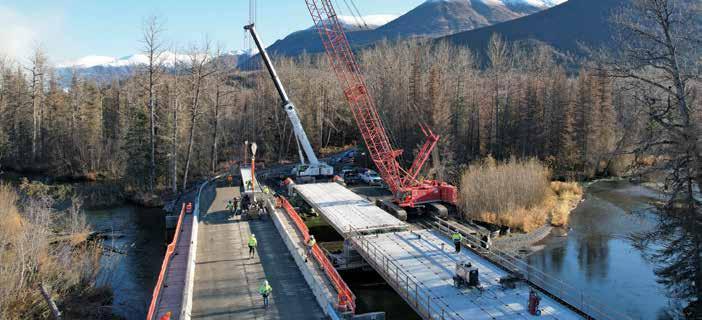

“We have worked very hard to build relationships with municipalities, tribes, nonprofits, and other nontraditional lenders to find the entrepreneurs that are seeking support and to make sure that we are giving them the option that is best for their business.”
Alana Peterson Executive Director Spruce Root
technical assistance from the Homeownership Council of America.
AGC is somewhat positioned in the middle between CDFI partners and conventional lenders. For instance, AGC relies on Spruce Root’s award-winning, nationally recognized Path to Prosperity curriculum for its regional Marketplace business plan competitions. Spruce Root serves as AGC’s lead facilitator of training. On the lending side, AGC exchanges referrals with Spruce Root and CILC. Miner explains, “Our teams are regularly meeting and figuring out how we can suppor t small businesses.”
AGC also collaborates with traditional lenders. “All of our loan officers here came from the conventional banks in Alaska, so they have deep connections with those lenders and are regularly meeting with them,” Miner says. “It takes a village to help move some of these big initiatives forward and to hel p small businesses.”
CDFIs often measure success by focusing on the “double bottom line” of economic gains and the contributions they make to the local community, according to the CDFI Coalition. CILC, for instance, measures the number of families or individuals who secure affordable stable housing through its homeownership programs as well as the number of businesses started or expanded due to its financing. CILC also assesses the businesses’ demographics and impact within the community. “We use a ‘mission matrix’ within our small business loan program,” Tickle says. “We track the number
of jobs created or retained through our small busine ss lending as well.”
CILC also plans to measure participation in financial education workshops and its soon-to-belaunched credit builder loan program. It will evaluate how its people are improving their financial literacy and long-term financial health through changes in credit scores, savings, and debt levels being tracked over time.
“We aim to collect client feedback and success stories to help us assess the broader, less tangible benefits of our ser vices,” Tickle says.
A recent funding success story of CILC is Yukon Tails, a mobile pet grooming business in Wasilla. Its owner, Teela Bieschke, identified the need for mobile pet grooming when she was unable to find services for her elderly dog experiencing mobility challenges. After being placed on lengthy waiting lists, she decided to start Yukon Tails. “Cook Inlet Lending Center was thrilled to partner with Teela and Yukon Tails to help launch this exciting new business ve nture,” Tickle says.
Spruce Root helped long-time client Edith Johnson launch Our Town Catering in Sitka. According to Peterson, Johnson’s journey included Spruce Root from the beginning when she received assistance to establish her LLC. From there, she participated in Spruce Root's training programs to start her first small business and worked on her personal finances to purchase her first home. By then, she was ready to approach Spruce Root for a loan to purchase her second business. “Her journey exemplifies our missions to
empower local talent and support local businesses,” Peterson says. “We feel so fortunate to be witness to the positive impact people like Edith have on our region's community, cu lture, and economy.”
One of TFCU’s proudest success stories is its work with the Metlakatla Indian Community. When the only bank branch on the isolated island closed in 2005, residents were left without access to essential financial services. TFCU stepped in by offering weekly services and, within a few months, opened a branch in the old bank building. “Over the years, we’ve introduced a range of services from home equity loans to financial education in local schools,” Mickel says. “Today, 85 percent of the community are Tongass FCU members, and the median credit score has risen by seventy-four points, reflecting the positive impa ct of our services.”
TFCU is committed to continuing its efforts to strengthen the economic resilience of Southeast, Mickel says. The credit union recently hired additional staff to support the growing team at its main office in Ketchikan, which oversees all its other locations. It’s also planning to build a larger office in Ketchikan to accommodate this expansion. Additionally, TFCU is expanding its financial education programs and introducing new financial products like Lifestyle Loans to meet the evolving needs of its members. Mickel says, “These initiatives, along with continued partnerships with local organizations, will help us provide the financial tools and resources that our communities need to thrive.”




By Scott Rhode
Pi zza toppings. Jay Leno reportedly compared the crazy-quilt pattern of the Atwood Concert Hall’s freshly installed carpet to Italian food in 1988 when he performed the venue’s inaugural show. Four decades later, the carpet is still there, a little worse for wear but holding up respectably.
The Atwood is the largest and most elegant of the three auditoriums in the Alaska Center for the Performing Arts (PAC). The city-owned structure is open to the public only a few hours per day, a few days per week, which cuts down on carpetscuffing foot traffic.
“My team does an amazing job of taking care of this facility that we are so fortunate to have,” says Codie Costello, president and chief operating officer of Alaska Center for the Performing Arts, the nonprofit organization contracted by the Municipality of Anchorage to manage the PAC.
Carpeting inside the Egan Civic & Convention Center, across Fifth Avenue from the PAC, was replaced a few years ago, but some forty-year-old fixtures are still there. “The ficus trees that were original to the building were seven feet tall; they now fill up the space,” notes Steve Rader, general
manager of Anchorage Convention Centers, the local branch of facility management firm ASM Global.
The Egan and the PAC are more than neighbors. They are manifestations of Alaska’s oil boom. Forty years ago, cashflow from the North Slope enabled the state treasury to bankroll public buildings in Anchorage. In addition to the PAC and Egan, the cohort included the Sullivan Arena, the new Loussac Library, a two- story atrium for the Anchorage Museum, and the Downtown Transit Center. Together, they were known as Project 80s. They were all built around the same time as Alaska's tallest skyscrapers, the ARCO Tower (now the ConocoPhillips Building) and the Hunt (now Atwood) Building.

The buildings have undergone some changes through the decades, and more facelifts are due as the Project 80s structures inevitably age.
The immensity of the PAC caught Costello’s attention in 2005 during a honeymoon visit. “We walked by this building and couldn’t believe that a community of this size had an asset like this,” she recalls. When a job opened up at the PAC, she jumped at the opportunity to move to Alaska.
“I can’t imagine Downtown Anchorage without the PAC,” she says.
Before the PAC, the block between Fifth and Sixth Avenues was known as Anchorage’s “skid row,” packed with bars and adult entertainment. In 1979, the firms of Hardy Holzman Pfeiffer Associates of New York and Livingston Slone, Inc. drew plans for a civic auditorium. Critics immediately wondered if it was too large, too ostentatious for the city.
The $71 million building stretched into F Street, and the right-of-way has been blocked ever since. The Anchorage Assembly voted 10 to 1 to name the PAC in honor of Martin Luther King, Jr., but a political backlash left the building without a proper name to this day. (King eventually got an Anchorage tribute with a road dedicated in 2010.)
Political activism also led to the creation of Town Square Park adjacent to the PAC. The block across Fifth Avenue had been reserved for future parkland, so a citizens committee insisted that Project 80s not interfere with that designation. When half of the block became the Egan Center in 1984, the town square development was part of the bargain.
“We’d be a very different place without these community venues… I think it’s important to acknowledge that gift. I think it’s important for us to reimagine how we invest in and maintain those gifts.”
Codie Costello President and Chi ef Operating Officer Alaska Center for the Performing Arts
Named for Alaska’s first state governor, William A. Egan, the $31 million center satisfied the city’s need for a facility to host larger meetings. Anchorage architect Edwin B. Crittenden designed a 45,000-square-foot building with some unique features. Elevated booths in the ground-floor Explorers Hall allow language interpreters to assist with international gatherings. Also, the ficus trees in the lobby required a special floor to irrigate their roots.
To make way for the Egan, the city demolished the original Loussac Library, built in 1952 and named for Zack Loussac, who ran Anchorage’s first drugstore and served a
term as mayor. His philanthropic foundation had funded the downtown library on the same block as Anchorage’s historic city hall.
Many of those city hall functions shifted to Midtown, where the Anchorage Assembly chambers were incorporated into the new Loussac Library. The castle-like edifice, with three cylinders linked by a massive bunker, opened in 1986.
Cylinders are a common motif at the four corners of the Sullivan Arena, completed in 1983 at a cost of $25 million. Part of the Chester Creek Sports Complex along with the nearby baseball and football fields and indoor and outdoor ice sheets, the arena is named after George M. Sullivan. The first mayor of the unified Municipality of Anchorage got the ball rolling on Project 80s buildings, while his successor, Tony Knowles, presided over ribbon cuttings later in the decade.
The Sully, as the arena is known, has seen busier days, hosting concerts, trade shows, and graduation ceremonies. It was the home of the Alaska Aces professional hockey team until that organization folded in 2017. UAA played hockey there until 2019. The arena hosted the Great Alaska Shootout college basketball tournament each Thanksgiving from 1983 to 2013. The following year, the university opened the Alaska Airlines Center, and the on-campus arena has cut into the Sully’s turf.
Last summer, the Anchorage Wolverines of the North American Hockey League relocated home games from the 700-seat Ben Boeke to the 6,200-seat Sully. After the season wraps up in April, the arena
is scheduled to host comedian Tom Segura. Rock band Five Finger Death Punch is booked to play the arena in August.
Not that it’s a contest, but the Anchorage Public Library system boasts of serving more visitors than the Sully. Nearly a million annual visits are spread among four other branch libraries while the headquarters at Loussac oversees circulation of more than 1.7 million books, media, and digital materials each year. Like the Anchorage Museum expansion and the Downtown Transit Center, it’s a Project 80s building that sees traffic nearly every day of the year.
The Egan has remained busy even though the Dena’ina Civic and Convention Center grabbed its crown as Anchorage’s premier meeting venue in 2008. ASM Global manages both buildings under a contract through Visit Anchorage, the nonprofit tourism bureau.
“If you live here and you’re maybe not Downtown as frequently, it’s really easy to not see the impact here. We have thousands of guests that are going through here on a daily basis,” says Rader of the Egan. “There’s a ton of activity; this is not an empty building.”
On the day of the interview, for example, while the US Bureau of Indian Affairs was meeting at the Dena’ina, the Egan’s downstairs conference rooms hosted the North Pacific Fisheries Management Council, and a boxing ring upstairs was set up for Thursday Night at the Fights.
“I think there’s a lot more going on in Anchorage—when it comes to meetings and conventions and being a cruise hub—than a lot of people realize,” Rader says. “All summer long, this is really a cruise hub for Anchorage.”
“Everything has their lifespan, so you reach the point where it makes more sense to go through the full modernization.”
Steve Rader General Manager
Anchorag e Convention Centers
Not having a waterfront cruise ship terminal, Anchorage adapted the Egan to that purpose. Holland America-Princess, Royal Caribbean, and Premier Alaska Tours use the curb frontage on Fifth Avenue to load motorcoaches and process luggage. Passengers can wait in the conversation pits in the expansive lobby. The building has evolved into Anchorage’s front parlor.
In addition to managing the Egan and Dena’ina, ASM Global used to manage the Sully. But that was before the global pandemic.
Five years ago, the Sully provided space for Anchorage’s homeless population to congregate at a safe distance during the COVID-19 pandemic. Stepping up as a shelter resulted in damage that Project 80s builders never anticipated, and entertainment functions were interrupted for three years.
Upon reopening in 2023, the Sully was under new management. Instead of Anchorage Convention Centers, the city tapped O’Malley Ice and Sports Center to operate the arena. Steve Agni and the late Sig Jokiel founded the organization in 1999, and it has grown into the largest sports facility operator in Alaska, owning and/or managing the O’Malley Sports Center, Kelly Connect Center, Dempsey Anderson Ice Arena, and the Ben Boeke Ice Arena.
The contract lets O’Malley collect 50 percent of the profits after deducting operating costs, while the city remains responsible for upkeep of the Sully, Ben Boeke, and Dempsey Anderson arenas.
The management situation is different at the PAC. The city pays Costello’s organization a flat fee, which covers about 20 to 25 percent of operating costs. Ticket sales and fundraising fill the rest of the budget.
“We’re pretty scrappy, and we make a lot happen with very little. However, after thirty-six years and limited investment, the building is in need of modernization,” Costello says. The punch list includes everything: plumbing, HVAC, theatrical lighting and sound, seats, and compliance with the Americans with Disabilities Act.
“We were built right before the ADA became law, so there are a number of things in this facility that weren’t addressed at the time of construction,” Costello says.
Indeed, the PAC was rushed to completion. Costello observes, “Our administrative offices, we sandwiched them in under the Atwood Concert Hall. But there was supposed to be a shared services and
administrative building (that included a rehearsal studio and offices), but that never came to be.”
From the moment of its completion, the PAC suffered from a leaky roof. A 2005 revenue bond funded a fix. While the roof has been repaired, Costello notes that the bond is still ten years away from being paid down.
Another minor alteration occurred in 2009 when aisles in the Atwood were widened by a few inches so that masked performers in The Lion King could safely step through the house. That modification will pay off again when the show returns to the PAC next season.
Loussac Library was likewise born defective. The original design called for a parking garage with a secondfloor entrance, but the economic decline of the mid-‘80s forced a change. The garage was scrapped, and library visitors had to brave a massive outdoor stairway, which was notorious for ice buildup until it was renovated in 2018.
The Sully received a $9 million renovation in 2015, including new seats, improved acoustics, and a video scoreboard as a handme-down from the Cow Palace south of San Francisco.
One upgrade at the Egan that wasn’t feasible in the ‘80s is the addition of rooftop solar panels. The building now has 212 panels supplementing its power supply. Rader says the energy savings over eight years is expected to exceed installation costs, totaling $700,000 in savings over the lifetime of the hardware.
“We’ve made some really great improvements in the last five years,” Rader says.
About twenty years ago, one of the most visible alterations was a skybridge over Fifth Avenue connecting the Egan and the PAC. The structure might seem frivolous, but Jennifer Ramsey, director of sales and marketing for Anchorage Convention Centers, says it has been useful. Performers at the PAC sometimes use the passage to make appearances at Egan events. And
Ramsey says she recently fielded an inquiry about the skybridge hosting a twenty-person dinner overlooking the bustling avenue.
Keeping the Project 80s buildings as shiny as when they were new takes constant maintenance. At the Egan, for instance, Rader says, “We’re doing a barrel glazing project to repair the

Tired of tiny hotel rooms?








Enjoy a full kitchen, separate bedroom, and a cozy living area at Sophie Station Suites - it’s like having your own apartment on the road! Book direct for the best rates, no hidden fees and flexible corporate options.




Looking west along Fifth Avenue circa 1983, when the Egan Center was under contruction, the left side of the image shows no sign of Town Square Park or the Alaska Center for the Performing Arts, which were both a few years from being built.
Ken Graham Photography

west entrance and skybridge.” That project will refresh the distinctive curved glass roof that shelters summertime tourists.
The Egan and Loussac Library are also due for elevator upgrades.
“Everything has their lifespan, so you reach the point where it makes more sense to go through the full modernization. They upgrade the cables and everything along those lines,” Rader explains.
Consolidated Contracting & Engineering won the job for the elevator modernization, totaling more than $1 million between the Egan and Loussac. Meanwhile, Visser Construction has a $434,331 contract for repairs to the Sullivan Arena plaza this year.
At the PAC, modernization is part of the Project Anchorage proposal for public improvements funded by a municipal sales tax. Whether adopted or not, and whether the PAC remains in the list of capital projects, Costello says upgrades are overdue.
“We are behind in technology, everything from sound to lighting. There are modernizations that we made along the way, as we’re able to find funds, but those investments are
significant,” she says. For example, the house lights in the Atwood were partially converted to more efficient LED fixtures, but not all of them. And for stage lighting, LED instruments that can “throw” 100 feet or more are the state of the art, but they are expensive.
Now that the PAC is a co-producer, with the Nederlander Organization, of the Broadway Alaska series, the need for up-to-date stagecraft is more urgent. Costello says the first couple of seasons made do with the PAC’s old equipment.
“The Broadway shows are unique in that, because they tour to so many different kinds of venues, they bring a lot of their stuff. But that also increases costs,” she says. “We can’t say to them, ‘Don’t worry. You don’t have to bring that because we have it here for you.’”
In a way, the citywide investments proposed for Project Anchorage are an echo of Project 80s, driven by the same spirit of civic pride, but without the windfall of revenue.
During the oil boom of the ‘70s, the population of Anchorage surged
from less than 50,000 to nearly 200,000. Presiding over that era as mayor from 1967 to 1981, George M. Sullivan envisioned a municipality with public buildings worthy of a grander city. In the next decade, Sullivan saw the vision take shape in concrete, steel, and glass.
While many of Anchorage’s historic buildings are 100-year-old cottages from the original townsite or midcentury relics of post-war expansion, Project 80s planted functional landmarks that signaled the city’s aspirations to world-class status.
“It’s iconic,” says Rader of the Egan Center’s glass barrel façade. “I think it adds allure for Anchorage. Beautiful design.”
Yet the buildings are only as monumental as the users who fill them. Of the PAC, Costello says, “This building is such a gift, and we are lucky to have it. It’s the home to many dreams and transformational experiences for all of our community.”
The library, museum, performing arts center, and other public facilities benefit the whole community. Costello says, “It’s part of what makes a community a community. A way for us to gather, to connect, to grow.”



By Tasha Anderson
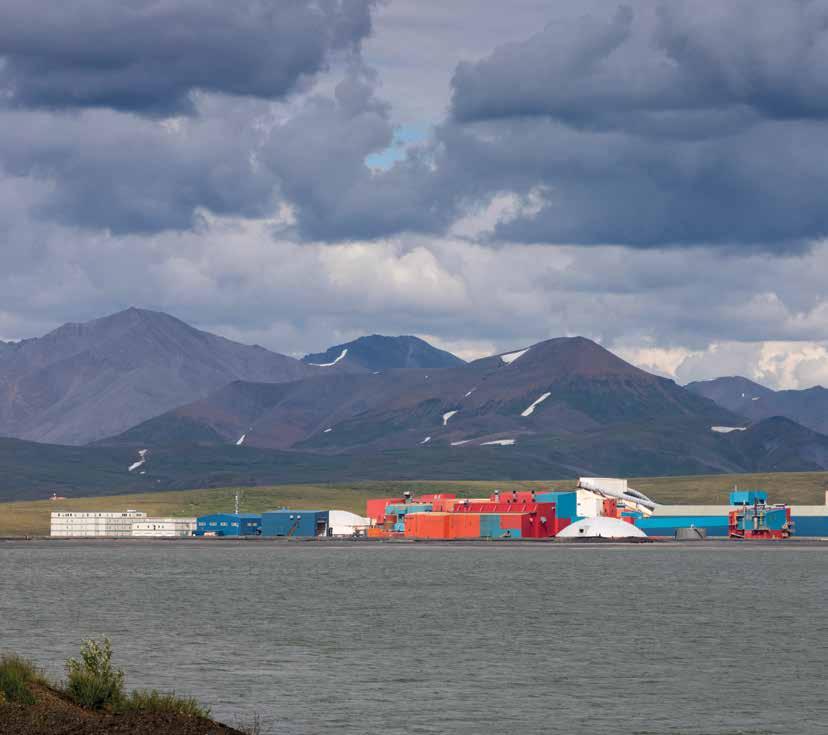
Re g Dog mine began operations in 1989 and currently has a projected mine life until 2031; however, in late November 2024, the US Army Corps of Engineers (USACE) announced its decision to issue a permit that allows for the construction of a road to support Teck Resources Limited exploration activities that could further extend operations at the mine—and its contributions to local and statewide economies.
Red Dog operator Teck and landowner NANA regional corporation welcomed the permit approval. According to NANA Vice President of Natural Resources Lance Miller, “This was the last permit needed to construct the exploration road and advance the evaluation of the project. This milestone was reached after many, many hours of work by Kivalina, Teck, and NANA leadership.”
Those many hours were in fact spread over multiple years.
Teck holds mining claims near Red Dog on state land: the Aktigiruq and Anarraaq mineral deposits, approximately 9 miles north of the Red Dog Mine. According to Teck Manager of Community and Public Relations Wayne Hall, the company submitted its initial Section 404 permit application to USACE in May 2018 to advance the exploration phase of the Aktigiruq Project. “Teck

worked closely with local subsistence hunters, who walked potential road routes with engineers to incorporate traditional and local knowledge in identifying the best route to minimize impacts in advance of the permit submission,” Hall says.
Teck resubmitted its permit application, which included additional information, to USACE in February 2022.
According to Teck, “The required tribal consultation process
“Our overall goal is to extend the mine’s life and continue the significant social and economic benefits the mine contributes to local communities and the region.”
Wayne Hall, Manager of Community and Public Relations, Te ck Resources Limited








I am a safety expert. I am a volunteer. I am mining.
I grew up watching the Fort Knox mine being built. Now I’m their health and safety coordinator and raising my own kids in the community. Mining has allowed my family to stay in the Interior and given me the skills to volunteer on the Borough’s Hazmat Response Team to support our first responders and help keep people in our community safe.
“With more than 85 percent of the NAB [Northwest Arctic Borough] budget from Red Dog and over 980 shareholder jobs earning about $63 million in annual wages, any gap may have significant negative economic consequences for the region.”
Lance Miller Vice President of Natural Resources
administered by the USACE has taken longer and has been much more complex than we anticipated and resulted in multiple delays from the original environmental review process schedule.” Just recently, a decision deadline of September 30, 2024 was extended to October 31, 2024—the eighth such deadline extension.
By late 2024, the project had received eighteen other required permits from state and local government agencies, with only the Section 40 4 permit remaining.
The permit’s approval in late November set the ball rolling for an exploration project that is now on a tight deadline.
According to Hall, “This permit approval is an important step forward which allows start of construction of the 9-mile access road needed to evaluate the technical and economic feasibility of two deposits that could potentially extend Red Dog mine's life.” Road construction began as 2024 came to an end, and construction of the road is projected to take nine to twelve months over two winter seasons.
According to an April 2022 Plan of Operations for the Aktigiruq Project exploration program that Teck submitted to the Alaska Department of Natural Resources, the company anticipates exploration activities would take place year-round for an estimated four years. If exploration progresses as expected and Teck delineates a technically and economically feasible deposit, the company could potentially extend Reg Dog mine’s life beyond 2031.
“Our overall goal is to extend the mine’s life and continue the significant social and economic benefits the mine contributes
to local communities and the region,” says Hall, adding that, even with the permit in place, “Time is of the essence to construct the exploration facilities and complete our evaluation o f mineral deposits.”
The April 2022 plan of operations noted that construction related to exploration activities would be divided into two phases, with Phase I seeking approval for “certain surface civil construction activities only,” namely construction of an approximately 9-mile access road, surface pads, approximately 3 miles of secondary access roads to the pads, and two material sites.
According to Teck, construction activities for Phase I will take place on state land, except for two segments of the access road and two material sites, which wi ll be on NANA land.
Phase II of the project would add additional aboveground infrastructure: a four-season camp, fuel storage facility, maintenance facility, core processing facility, offices, water treatment plants, power generation facility, other support buildings, and a stockpile area for transient waste rock. Underground exploration activities would include developing “approximately 80,000 feet of underground exploration ramps and drifts and executing approximately 300,000 feet of exploratory drilli ng,” Teck explains.
The ultimate goal is to extend Red Dog Operations beyond 2031 and to do so without an extended gap
in production. According to Miller, “With more than 85 percent of the NAB [Northwest Arctic Borough] budget from Red Dog and over 980 shareholder jobs earning about $63 million in annual wages, any gap may have significant negative economic consequences for the region. Any delay has economic implications that will impact direct and indirect workers, communities, the NAB, NANA, and many others depending on the length of shutdown.”
For 2023, Red Dog generated approximately $1.6 billion in revenue, with a gross profit of $408 million, producing 540,000 tonnes of concentrate. Beyond the benefits directly to the region and NANA shareholders, revenue from Red Dog is distributed through the Alaska Native Claims Settlement
Act 7(i) and 7(j) revenue sharing provisions, which means Red Dog money spreads to every region of the state. According to Teck, Red Dog Operations have provided more than $3 billion in royalties to Alaska Native corporations, including NANA, over the mine’s life. Approximately $2 billion of that has been shared with other Alaska Native regional and village corporations.
Hall says the company “is proud to be a major employer in the Northwest Alaska region providing secure, high paying jobs.”
Teck says it is “diligently working to minimize a gap in production” and that securing this permit was key to advancing exploration at Aktigiruq, which “could hold the greatest possibility of extending Red Dog’s mine life, the largest zinc mine in the world.”
According to Teck, Red Dog Operations is an important part of North America’s critical minerals supply chain. Zinc concentrate from Red Dog is shipped to Teck’s Trail Operations in British Columbia, Canada— one of the world’s largest fully integrated zinc and lead smelting and refining complexes—where it is converted into refined products, including germanium, and sold to about 100 customers i n the United States.
Hall continues, saying “We are committed to continuing to work collaboratively with local communities, government, and regulators to responsibly extend Red Dog’s mine life and continue the significant social and economic benefits the operation contribut es to the region.”
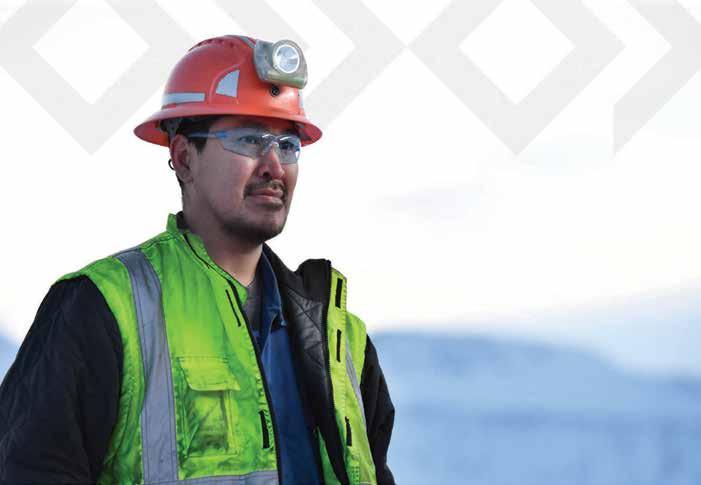

By Terri Marshall

On e of the most popular attractions in Fairbanks is leaving the Wedgewood Resort. The Fountainhead Antique Auto Museum has wowed locals and visitors since opening in 2009. The renowned collection of antique cars and vintage fashions was voted by Alaska Business readers as one of the best museums in the state in 2024, alongside the Anchorage Museum and the Alaska Aviation Museum at Lake Hood. The museum has made its mark, and now it’s moving away from the nest of Fountainhead Development, the owners of the resort property in north Fairbanks.
In 2025, the Fountainhead Antique Auto Museum is moving across Chena River into the former Kmart building on Airport Way, now partially occupied by an Amazon fulfillment center. The new location will expand on the story of Alaska transportation through a partnership with the Interior and Arctic Alaska Aeronautical Foundation, operator of the Pioneer Air Museum currently located in the Gold Dome at Pioneer Park, a few blocks away from the merged museums’ new home.
“Our partnership with the Pioneer Air Museum will allow us to weave together the vibrant histories of aviation and the automobile in the
Far North, presented in vivid detail with rare artifacts and captivating exhibits highlighting Alaska’s transportation pioneers,” says Tim Cerny, Fountainhead Antique Auto Museum founder and owner.
Fountainhead Antique Auto Museum showcases the evolution of automotive technology and cultural shifts of the twentieth century. “In our fifteen years of operation, we have continued to add significant vehicles to our collection as well as enlarging the fashion collection that dates back to the eighteenth century and continues through the post-World
War II era,” explains Cerny. “The clothing tells the story of fashion and design over centuries.”
This “living museum” houses more than ninety-five pre-World War II automobiles, with sixty-five to seventy-five rare automobiles staged at all times. This expansive collection encompasses cyclecars, electric cars, horseless carriages, midget racers, speedsters, steamers, and ‘30s classics.
The fashion component of the museum started with just a few displays and is now considered the most extensive collection of vintage clothing in the Pacific Northwest.
“It was so popular that we decided to expand it,” says Cerny. “My wife, Barbara, is in charge of the fashion component of the museum along with two ladies (both named Connie) who work with her. They focus on acquisition, staging, and building the story of fashion over decades.”
Most recently, the museum team has been working to acquire a group of vintage wax mannequins that were used for clothing displays from 1900 through the ‘30s. “Over the past five years, we’ve been able to purchase about twentyfour individual mannequins modeled after real people at the time they were used,” explains Cerny. “I supposed they would be considered the ‘influencers’ of their time, allowing their images to be used and incorporated into departm ent store displays.”
The exhibits that have been a hit with visitors will tell a more complete story when blended with the Pioneer Air Museum. Cerny says, “We’re very excited about being able to enlarge the story and integrate aviation with the automotive industry and how it changed Alaska.”
“We’re
Tim Cerny, President, Foun tainhead Development






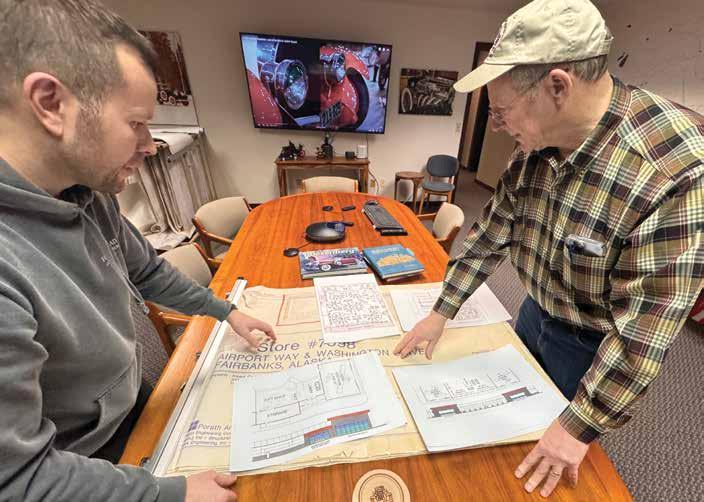
Among the aviation treasures from the Pioneer Air Museum are the Noorduyn UC-64A Norseman Airplane and the remains of Ben Eielson’s plane. Eielson, who delivered the first air mail in Alaska in 1924, died five years later in a plane crash while flying supplies to a ship frozen in the Bering Sea. The new museum will bring such stories to life through displays and interactive exhibits.
“Nowhere in the continental United States did the airplane play such a significant historical role as it did in Alaska,” says Richard Wien, son of Eielson’s contemporary Noel Wien and a legendary bush pilot himself.
“I think it is so exciting that Tim Cerny has agreed to include Alaskan aviation history along with his worldclass auto museum. With the new location, I’m sure it will become a
must-see for visitors and historians.”
The conversation of the possibilities of moving to a new location and blending both museums began during the COVID-19 pandemic, in anticipation of tourism returning to normal. Both organizations were looking forward to something bigger and better.
Cerny says, “The new Fountainhead Transportation Museum will provide exhibit and storage space for over 135 vintage automobiles, several rare airplanes, thousands of vintage fashions, and other rare artifacts. We are very pleased to partner with individuals who work and support the aviation museum and are excited to participate in telling the Alaska transportation story.”
“I am extremely excited about the future of this museum,” says Eric Johansen, president of the board
of the Pioneer Air Museum. “The museum will be a must-visit for residents and visitors alike, who will come away with a real appreciation of the many obstacles overcome by Alaska’s early aviation pioneers.”
Cerny’s company, Fountainhead Development, has been working with Design Alaska to create 90,000 square feet of exhibit space, a restoration area, climate-controlled artifact storage, a gift shop, a reception area for groups, and a catering kitchen.
“The new space will also offer more audio/visual experiences,” shares Karen Wilken, marketing and public relations manager for Fountainhead Development. “With the added space, we will be able to have more interactive exhibits that tell the gritty stories of our
pioneers who paved the way for transp ortation in Alaska.”
As both the automobile and vintage fashion collections continue to grow, Cerny is looking forward to more display space in the old Kmart building. “The new space has 90,000 square feet of floor area in contrast to our existing 30,000 square feet. Currently, we can display up to 85 vehicles from our collection of about 130 vehicles, which requires quite a bit of stock rotation. The new location will give us the space to tell an expanded story of technological development and design elements in the vehicles.”
The museum also vividly details Alaska's rich and colorful auto and transportation history. Its walls display 100 historic motoring photographs illustrating the state’s unique transportation challenges, including the navigation of glacial streams, avalanche chutes, and extremely deep snow.
Cerny says, “We have a great team moving forward, which includes our outstanding docents and our historian, Nancy Dewitt, who wrote three books on transportation in Alaska. She will be back on staff working with us to help develop the integration of the aviation industry.”
Moving delicate aircraft into the new museum requires significant expertise. TOTE Maritime Alaska and the Alaska Railroad recently donated shipping services for two additional historic Alaska airplanes that are being moved from Spokane, Washington to Fairbanks.
In preparation for the move from Wedgewood Resort to the new location on Airport Way, the Fountainhead Antique
“I think it is so exciting that Tim Cerny has agreed to include Alaskan aviation history along with his world-class auto museum... I’m sure it will become a must-see for visitors and historians.”
Richard Wien, Co-founder, Alaska Air Carriers Association
only Alaskan place to stay for charm, culture and cuisine.




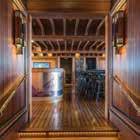




Featuring distinctive dining experiences, a full-service espresso bar, unique shops and both men’s and women’s athletic clubs.
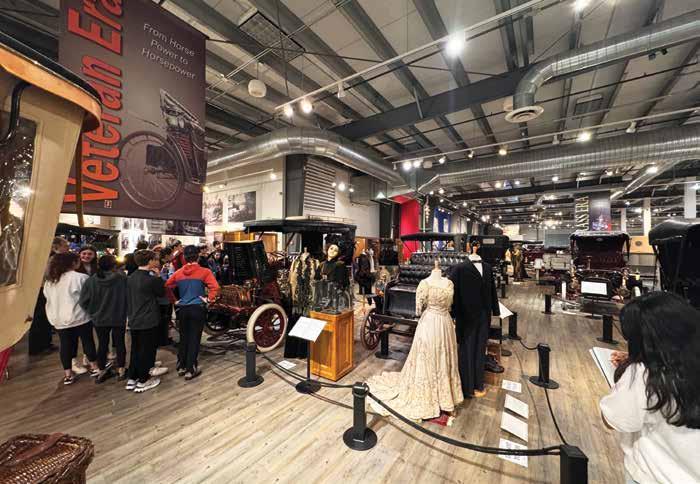
Auto Museum will remain open through the tourist season, with the expectation of the last of the larger tour groups concluding the last week of September.
“We will start moving and assembling some of the airplanes in the summer of 2025,” says Cerny. “As for the vehicles, since we are a living museum, the majority of our vehicles are in running condition, and we take them out dr iving every summer.”
Thus, the relocation provides a rare opportunity for an open-air mobile exhibit. Cerny says, “For the transfer, we’ll have several parades of antique cars driving through Fairbanks as we move from the existing museum to the new space.”
The current museum space at Wedgewood Resort will be converted
into a convention center and event space. “We’ve been advocating for a convention center for the better part of two decades,” says Scott McCrea, president and CEO of Explore Fairbanks. “We felt like a convention center was the missing asset to a solid tourism industry here in Fairbanks. Now, with the current location of Fountainhead Auto Museum at Wedgewood Resort being converted to a conference and event space and the recent opening of the 8 Star Events Center space, we will have more optio ns to offer groups.”
As a vibrant year-round destination, Fairbanks tourism stands to benefit from the additional space for meetings. “The economic impact of meetings and conventions can be pretty significant for a community,” explains McCrea. “We’ve seen what it does in terms of economic
contributions to hotels, restaurants, and shopping venues.”
McCrea also expects to benefit from the potential for meetings and conventions in the community’s shoulder seasons. He says, “We have solid summer and winter seasons for tourism, but with this new space, attracting meetings and conferences during the shoulder months like April and October will add a significant economic impact.”
The Explore Fairbanks team is also excited to witness the union of the Fountainhead Antique Auto Museum and the Pioneer Aviation Museum. “The Fountainhead Antique Auto Museum is a gem within our local tourism industry. People who go there are just in awe of its collection,” shares McCrea. “With aviation being so critical to our history and growth as a state, we think this will be an extremely successful union.”


Use your savings at any eligible university, college, vocational school, apprenticeship, or even K–12 public, private, and religious schools.
Answer “Yes” to the Alaska 529 question on the PFD application to contribute half of a PFD into an Alaska 529 account, and you will be automatically entered to win a $25,OOO scholarship account.*
Go online to request a Plan Disclosure Document, which includes investment objectives, risks, fees, expenses, and other
You should read the Plan Disclosure Document carefully before investing O ered by the Education Trust of Alaska. T. Rowe Price Investment Services, Inc., Distributor/Underwriter. *Certain restrictions apply; visit Alaska529plan.com for complete rules.

by Rachael Kvapil
Hy drocarbons are the backbone of Alaska's energy wealth. Oil and natural gas, composed of carbon molecules studded with hydrogen atoms, continue to shape the state’s future. But the state’s rocks may also hold a simpler, cleaner resource.
More than 100 people gathered at UAF in October to discuss the potential of geologic hydrogen. This process, different from industrially produced hydrogen, is still in its infancy. However, this isn't stopping key players from sharing information in hopes of discovering a breakthrough that will lead to a viable commercial product.
The first internal combustion engine in 1806 burned hydrogen.
Ever since, the most abundant chemical element in the universe has held potential as the next big energy storage medium. The gas doesn’t count as an energy source, exactly, because humans need to add energy to make it. Either hydrogen is stripped from methane in natural gas or, less commonly, separated from water molecules. When hydrogen recombines with oxygen, some of that energy is released for useful work.
Geologic hydrogen, though, is an energy source. The hydrogen gas forms naturally by geological processes deep within the Earth. Deposits formed from these processes can be accessed and recovered by drilling. Because of its purity, geologic hydrogen is referred to as “natural,” “gold,” or “white” hydrogen.
“It's hard to find a single resource that could have such a big impact on our world in the way of helping our energy transition to move forward,” said Dr. Mark Myers, Commissioner of the US Arctic Research Commission, during his opening remarks at the Geologic Hydrogen Workshop 2024 hosted by UAF.
Myers says that Arctic communities need additional sources other than electricity to meet energy demands, so the distribution of geologic hydrogen has the potential to fuel areas that don't have access to oil or gas.
Though geological settings conducive to natural hydrogen may exist in Alaska and the broader Arctic regions, geologists have yet to fully study and assess their potential. The workshop was a
step forward in determining what is needed to develop a sustainable research effort in Alaska and identify the policies and regulations required for research, exploration, and development. Presenters also outlined the utility, economics, storage, and transportation realities that are part of making natural hydrogen a viable fuel source in a competitive energy market.
Michael Sfraga, Ambassador-AtLarge for Arctic Affairs with the US Department of State, says energy plays a significant role in the national strategy for the Arctic region. This strategy comprises sustainable economic development, environment and climate, national security, and international cooperation and governance. In his opening remarks to conference attendees, he identified seven drivers of change in the
Arctic that also affect other parts of the world: climate, commerce, commodity, connectivity, community, cooperation, and competition. As he expounded on these drivers, he pointed to recent events that disrupted the energy industry, such as the war in Ukraine. Likewise, he emphasized working together to navigate these seven Cs so everyone benefits from resource development.
“Energy filters through everything my department has addressed,” Sfraga said. “In meeting with allies and friends, energy comes up in every discussion. That's why this is really important.”
The cross-section of presenters covered the spectrum of energy stakeholders. Representatives from private industry, Alaska
Native organizations, government, and regulatory and resource management agencies attended alongside international experts on geologic hydrogen and Alaska geology. Researchers from the US Geological Survey gave multiple presentations that touched on different aspects of geologic hydrogen, such as systems, generation, Alaska composition and distribution, and current research. Other presenters included the US Department of Energy National Laboratories, the US Department of Energy Advanced Research Projects Agency-Energy (ARPA-E), The University of Texas at Austin’s Bureau of Economic Geology, Cornell University, Alaska Department of Natural Resources Geological and Geophysical Surveys, and the Geological Survey of Finland.

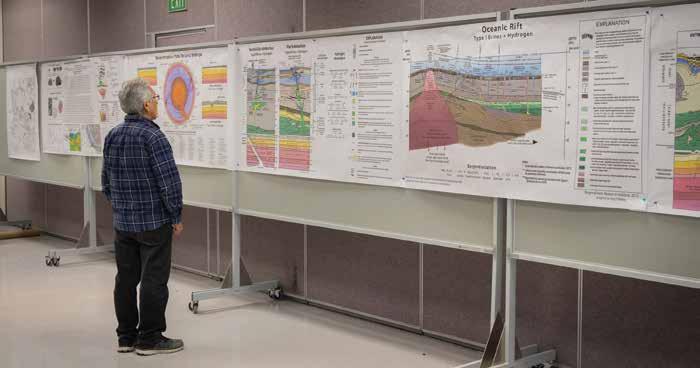
Much of the discussion surrounding the identification of geological hydrogen sources was technical and benefitted from background knowledge of the processes. However, presenters provided multiple visuals to illustrate their research and projections.
Eric
Marshall | UAF Geophysical Institute
“All of this is still in its infancy… The Department of Energy is focused on stimulation and engineering. We are not looking at exploration at the time.”
Douglas Wicks, Program Director, Advanced Research Pr ojects Agency-Energy
Much of the information presented was technical and required a background knowledge of the chemical and geological processes by which natural hydrogen can be continuously generated. In a nutshell, certain rocks can undergo mineralogical and chemical reduction (an atom gains electrons) or oxidation (losing electrons) when they encounter water. The process called serpentinization moves ironrich rock from the oceanic crust up through tectonic processes, and when it meets with water, iron is released while water is reduced to hydrogen. Much of what is known about the geological characteristics that create these reactions in Alaska is based on what has been found in Canada, Russia, Australia, Germany,
New Zealand, and other places with similar geologic conditions.
At least fifty companies are actively exploring and extracting geologic hydrogen, yet the most talked-about producer is Bourakébougou, a village in Mali. Locals drilling a water well in 1987 accidentally discovered a deposit when a villager sparked an explosion by lighting a cigarette near a breeze emanating from the hole. The breeze turned out to be a steady stream of natural hydrogen gas. To prevent additional accidents, the hole was cemented shut until 2012, when a Canadian company now known as Hydroma tapped the hydrogen to supply residents with electricity. From 2017 to 2019, Hydroma drilled twenty-four wells in the Bourakébougou fields.
Though many workshop presenters referred to the Bourakébougou as an example of what's possible, they also were realistic about the discovery and scale of the project. The shallow reservoir layer provides 5 to 50 tons of natural hydrogen per year (the equivalent of 0.3 to 3 barrels of oil per day) and less power output than a tenth of a single mediumsized wind turbine. However, this finding and other prospects in Albania and France spurred additional research and exploration in Europe, Asia, Scandinavia, South Ame rica, and Australia.
“The United States is late to the game,” said US Geological Survey Research Geologist Geoffrey Ellis in his presentation on the historical
contexts of geologic hydrogen and an overview of th e rest of the world.
Intermixed with scientific presentations were additional conversations about upcoming funding for research and exploration. ARPA-E has provided pockets of funding through its Geologic Hydrogen Exploratory Topics project categories. In February, ARPA-E funded $20 million for sixteen projects across eight states that focus on accelerating the natural subsurface generation of hydrogen. The awarded projects are from a mix of universities, national labs, and private businesses conducting early-stage research and development to advance low-cost, low-emissions hydrogen. All the funding recipients awarded since 2023 are in the Lower 48.
“All of this is still in its infancy,” said Douglas Wicks, ARPA-E program director, in his presentation. “The Department of Energy is focused on stimulation and engineering. We are not looking at exploration at the time.”
Several companies operating in Alaska are funding their own research into hydrogen conversion, generation, storage, and exportation. Representatives from Alyeschem, Amp Energy, Treadwell Development, and Stillwater Critical Minerals presented different theoretical models, cost analyses, and timelines that forecasted the market feasibility of geologic hydrogen anywhere from ten to twenty or more years in the future.
Economics and logistics aside, there are other challenges that producers, legislators, and other entities will need to tackle before major exploration occurs in Alaska. The first


is land ownership. Regional and village corporations collectively own 44 million acres, much of which contain geological formations well-suited for natural hydrogen. The circumstances in which exploration occurs on Native lands remain to be seen. Likewise, the regulations that guide drilling, production, and transportation are undefined. Key Alaskan legislators who attended the conference say the state's experience developing oil and gas regulation will guide the process, but it doesn't necessarily mean the results will be the same.
Ultimately, experts agree that it will take a big find or a decrease in exploration costs before leaders invest significantly in geologic hydrogen. They encouraged everyone to keep moving forward with research and development so that everyone is ready when the opportunity comes.


in-person degree or certificate programs, or a fully online program with UAF eCampus. Empower them to get one step closer to their career goals — on their schedule, wherever
• Online degrees with flexible schedules for rotational workforces.



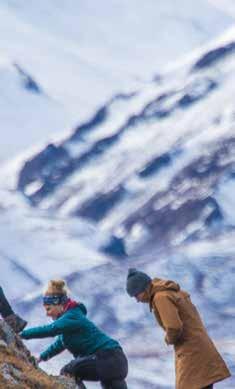






Projects in architecture and engineering, be they monumentally large like Project 80s buildings or tiny homes in Petersburg, are manifestations of the talent, teams, techniques, and tools that make them. For talent, look to the nominees for the Engineer of the Year awards for 2024. They bolster teams ranging from firms like Design Alaska to associations like the Society for Marketing Professional Services, a network of business development experts who connect firms to clients.
Techniques include the specialized knowledge that goes into fire protection engineering or interior design—knowledge that must stay up to date with the latest innovations. Those new tools might be 3D printers that squirt out concrete walls or AIdriven software that can amplify a small company’s reach.
But enou gh tease; let’s get to the Ts.














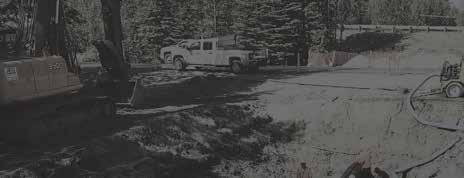


























By Scott Rhode

In terior design deserves to be taken seriously. Dana Nunn, interior design director at Bettisworth North, would like to see more respect for her profession.
“Public perception is largely that interior design is a luxury for the very elite who can afford it at home. Or it is picking paint colors and doing the surface things,” Nunn says.
Basic cable TV shows made some Alaskans look like heroes: crabbing crews, gold dredgers, ice road truckers. But interior designers had to endure the shame of Trading Spaces . Not every project involved a bale of straw glued to a living
room wall, but more than zero did. That’s tough for a hard-working professional to live down.
Nunn says people only notice the surface of a designed space.
“Everything else we do is behind that,” she says. “Finishes is less than 5 percent of what an interior designer does.”
The percentage is the same at Anchorage-based MCG Explore Design, according to the designers there.
“Anyone can pick a paint, but not everyone understands what it will
do to the space,” say MCG principal interior designers Melissa Pribyl and Cara Rude. “We also space plan, design ceiling plans, and coordinate lighting and electrical needs with our engineering consultants. We understand the building codes and how to properly egress occupants, and we design for inclusivity and allow for individuals of all ages and abilities to safely interact with the space.”
When not choosing fabric or paint swatches, designers are busy with interior space analysis, planning and design, non-bearing interior construction drawings, furniture

and finish specifications, and management of interior construction and alteration projects in public and private buildings. Pribyl and Rude explain that interior designers must comply with building design, construction, and life-safety codes.
Registered interior designers are qualified by education, experience, and examination to provide these services.
Nunn adds, “We don’t design the electrical system for the lights, but we communicate to the electrical engineer what kind of lighting we need, where we’d like it placed, what kind of surface they’re interfacing
“Architecture is an age-old profession, and interior design (similar to landscape architecture) is a relatively new profession… That barrier has been falling away pretty slowly but consistently since the late ‘80s.”


Building thriving communities, together.



f Civil Engineering
f Structural Engineering
f Mechanical Engineering
f Electrical Engineering
f Fire Protection Engineering
f Corrosion Control Engineering
f Alternative Energy
f Commissioning
f Landscape Architecture
f Process Engineering
f Process Safety Management
f Trenchless Technology Engineering
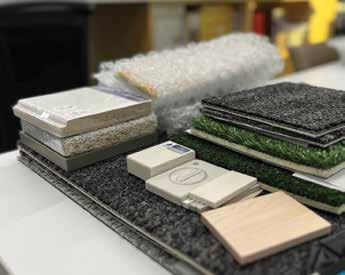

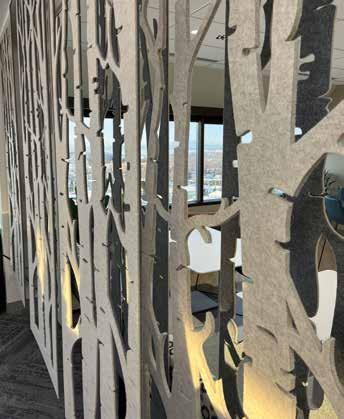
with. What are the functions we’re supporting, and what kind of controls do we need?”
As she puts it, an architect suggests where lights should go, and the electrical engineer plans the wiring and ensures proper light levels. Nunn was trained to calculate light levels, and she’s done them on smaller projects, but at an integrated firm with engineers on staff, she usually doesn’t have to.
Nunn is less involved in drafting and modeling these days; as a supervisor, her role is to develop a project's program, contribute to the concept, and influence the design direction, while also overseeing schedules and budgets. After twenty years as a designer, she says, “I have projects in over ninety Alaska cities and villages, and I have nearly seventy unique project types in my twenty-one years of working in Alaska.” Those types range from morgues and water treatment facilities to theaters and museums.
The purpose of a building guides the designer’s approach. The first step, according to Pribyl and Rude, is a program for the space, setting goals for how occupants will use it and how the shape of the structure supports those goals. Interior designers collaborate with other professions to meet these goals.
“Do they need a sink? Does the icemaker need a floor drain? If yes, you will need a mechanical engineer. Do the additional electrical outlets max out the existing electrical load? If yes, then you will need an electrical engineer. Do they want to have shelving installed above 6 feet? If yes, they need a structural engineer for seismic stability,” say Pribyl and Rude. They compare the collaboration to the different positions on a soccer team.
When collaboration goes wrong, the results might be public restrooms that are inaccessible to all users, flooring with measurably high rates of slip-and-fall accidents, or fabrics that break down under repeated cleanings, which can be an infection hazard in healthcare or restaurant settings.
A skilled interior designer minding the net (to extend the analogy) can keep these mistakes from slipping through.
Surface finishes and space programming are also the domain of architects, who might have their own ideas. Nunn’s colleague at Bettisworth North, architect Heather Kapala, welcomes the overlap. “You want the outside to speak to the inside,” Kapala says.
Literally, in some cases: Nunn notes that interior designers might sometimes coordinate with landscape architects to unify indoor and outdoor spaces.
Pribyl and Rude call the relationship a “fluid process with a collective goal.” A project needs both to succeed.
Pribyl says, “Architecture is broad in scope, but specializations like landscape architecture and interior design have evolved to the point where they are now recognized for their unique expertise. This parallels the different specialties of engineering, such as electrical, mechanical, civil, and structural engineering.”
Rude adds that most of the world uses the term “interior architect” instead of interior designer.
“Architecture is an age-old profession, and interior design (similar to landscape architecture) is a relatively new profession,” says Nunn. Historically, interior decorators were tradespeople hired by architects. As the specialty has professionalized, Nunn says, “That barrier has been falling away pretty slowly but consistently since the late ‘80s.”
Interior designers and architects now meet eye to eye as certified professionals. A designer can earn a fouryear college degree and take the three-part exam from the Council for Interior Design Qualification that focuses on health, safety, and welfare codes.
Kapala says, “Interior design and architecture should not be in a vacuum, separate from each other. The more


that the wall between is brought down, the better the project ends up being.”
“The best projects are when we’re working together and not working siloed,” adds Nunn. “The client experience is better. The project outcome is better.”
As an example of collaboration, Kapala notes that she and Nunn recently attended a conference together, and they both learned about accessibility in design.
“There’s overlap in the continuing education we do, between interior designers and architects, so that helps keep that bridge alive. We’re both learning about the same new things,” Kapala says.
Much of an interior designer’s working hours are occupied with project-based research, literature reviews, and seeing what’s available on the market.
“It’s about building your bank of knowledge and resources. When the opportunity strikes, you’re prepared to offer the best,” Nunn says.
Kapala adds, “It’s really satisfying when a client is like, ‘Wouldn’t it be great if we had something like…?’ and you’re, ‘Actually, I do.’”








Attending conferences and other continuing education keep designers abreast of the latest industry innovations.
Pribyl cites some new techniques that MCG is adopting, such as biophilia and biomimicry, environmental psychology, and virtual renderings. Pribyl and Rude were the first designers in Alaska certified in the WELL Building Standard, a 2013 rubric for best practices in environmental quality and occupant wellbeing.
Bettisworth North’s offices in Anchorage serve as a showcase for the latest interior design features. Nunn says clients can visit to see how certain features might work, from the sliding partition panels resembling a birch forest to the seamless threshold between carpet and wood flooring.
The office also demonstrates an active acoustic system in the ceiling. “We have it everywhere, and we have it zoned. Our conference rooms and small meeting rooms are in one zone, so we can turn it down a little bit more,” Nunn explains. “And we have another zone in what we call our living room—our kitchen area and design lab—because those are the most rambunctious. And we have the open office space; it’s turned up a little more there.” The system is not noise canceling, she clarifies, but tuned white noise.
Whatever innovations might pop up next, the skilled interior designer is the first to know.
Every certified designer working in Alaska had to bring their skills back into the state. Although engineering degrees are available in Alaska, the state has no interior design school (nor architecture, for that matter).
Furthermore, the state does not yet recognize interior designers as a licensed profession, but Nunn is trying to change that. She is urging legislators to pass a bill that would add interior design to the professions overseen by the Board of Architecture, Engineering, and Land Surveying. It would not mandate that designers register, but those who do would be allowed to practice independently.
If passed, Alaska would join fifteen states that allow designers to practice independently; a dozen other states regulate the professional certification of designers.
Nunn, for example, is registered in Texas, but she cannot practice independently in Alaska. “If I want to practice in the public realm—impacting public health, safety, and welfare—I have to have the oversight and over-stamp of an architect,” she says, acknowledging that this is less of a problem at an integrated firm like Bettisworth North.
The same goes for MCG, except that designers would be able to sign and author their own work.
Rude says, “After twenty-two years of interior design, I will finally author work in my home state of Alaska. As a fine artist, there has never been a time I didn’t sign my work or had someone add their signature after a critique.”
Professionalizing the field, she says, would create an Alaska-hire incentive for professional interior design and attract high-quality design talent to Alaska, as students studying Outside can return home for career opportunities.
However, the legislation introduced last session failed to pass the Alaska House or Senate, and not for the first time. “We’ve found that understanding and recognizing the relevance and the rigor of the educational path is lacking,” Nunn says of the bill’s opposition.
Although architects have voiced concern that independent interior designers would take business away from them, Nunn doesn’t see it that way. “There’s so much work in Alaska. If you do good work and maintain your client relationships, then there’s no threat,” Nunn says.
At MCG, Rude has the support of her colleagues. “Our partners who are architects are in full support and recognize the growth and expertise of interior design,” she says. “I have high hopes the system will soon reflect this.”
Professionalizing interior design is “sweeping the country,” Nunn says, but the Alaska legislation has taken seven years so far. That’s not an uncommon timeframe, Nunn observes optimistically.
“I hope it’s not another seven years... We’ll see how it goes.”






How Petersburg is tackling its housing shortage
By Katie Pesznecker
Li ttle Norway has a big problem with a tiny answer.
The Petersburg Borough is facing mounting pressure to address a lack of affordable and available housing, a challenge that threatens local growth and stability.
Petersburg is known for its natural beauty, rich Norwegian heritage, and strong commercial fishing roots. The quintessential island community is a residential draw for people seeking small-town life amid stunning Southeast scenery. But the limited availability of homes has capped the population at about 3,000.
In 2023, the Petersburg Borough took a bold step by introducing the Permit-Ready Accessory Dwelling Unit (PRADU) program. This initiative provides pre-approved designs for tiny homes, offering a streamlined path for residents to create
additional housing—and generate income—on their properties. The innovative program has the potential to positively alleviate the small town’s housing crunch, one tiny home at a time.
One House at a Time
Petersburg’s housing shortage is not new. For decades, the market has been tight, with limited rental and purchase options. According to the Petersburg Borough Housing Needs Assessment, prepared by Agnew::Beck Consulting in 2023, the borough needs 316 housing units over the next decade—133 new constructions and 183 rehabilitations—to meet demand across all income levels.
The study revealed several critical challenges facing Petersburg’s housing market. With a vacancy rate

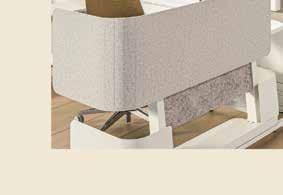

“Petersburg is a special place… The PRADU program shows what’s possible when a community comes together to solve its challenges.”
Hildie Cain Architect


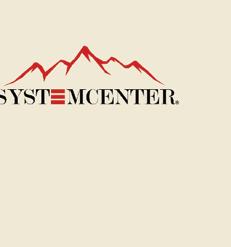
Systemcenter Alaska delivers innovative furniture, storage, and design solutions tailored to enhance your team’s performance potential. As your trusted Haworth dealer, we create efficient, space-saving, and inspiring workplaces that prioritize comfort, productivity, and growth.
Contact us today for a free consultation to design a workspace that works for you.
systemcenter.com/alaska
“In our minds, we might build hundreds of these, and we didn’t want everyone’s backyard to look the same. The idea was to make it affordable, make it look nice, make it fit in with the community.”
Hildie Cain Architect
of just 1.2 percent, finding available housing is almost impossible, creating significant hurdles for residents looking to relocate and for employers attempting to recruit workers. Compounding the issue is the borough’s aging population and housing stock, which is dominated by single-family homes, making up 72 percent of all housing. This leaves limited options for younger families and transient workers.
Affordability is another major concern, as more than 40 percent of renters and 15 percent of homeowners are cost-burdened, spending more than 30 percent of their income on housing. Adding to the crisis are barriers to development, including high construction costs, a shortage of skilled labor, and a lack of developable land. Together, these factors paint a challenging picture for the borough’s housing landscape.
“Just like most of Alaska, Petersburg is experiencing a shortage of available housing,” says Liz Cabrera, Community and Economic Development Director for the Petersburg Borough. “We don't really have anyone building spec homes; instead, it’s almost always one house at a time for a specific family. It takes quite a while to build up any surplus housing stock.”
The limiting factor isn’t land, says Hildie Cain, one of the architects who worked on the tiny home designs.
“There’s plenty of land available,” Cain says. “It’s buildable land. But it’s expensive to build here. Getting materials in and out of here is expensive. It’s getting better, and you can certainly do it. But there’s no attraction for a developer to come in and build ten houses.”
Cain says much of the new construction is recreational properties
that are only occasionally used, or new homes for retirees.
“For retirees, it’s their second homes, third homes—and they’re nice homes,” Cain says. “They’re beautiful, they’re huge. The last one I looked at had its own wine cellar. But what they’re for is for people to spend two to three weeks here. The people who really need the housing, like transient hospital workers, families moving here—there’s nothing to buy.”
Cain has seen firsthand how tough it is for newcomers to find housing. Some people end up staying in hotels for long spells. Cain says, “We have a Petersburg buy/sell/trade site online, and every once in a while we’ll see someone saying, ‘Hey we’re moving there, what’s available to rent?’ And there’s this long silence. Our realtors are really good at finding people housing, but you have to know to go ask them.”
The PRADU program emerged from the borough’s Housing Task Force and the findings of the Housing Needs Assessment. Cabrera played a pivotal role in researching potential solutions, drawing inspiration from similar programs in the Lower 48.
“Our department is small and certainly couldn’t take on the job of developing new housing,” Cabrera says. “I began to research communities down south that have been facing housing issues for years to see what types of programs they used. Eventually, I came across this idea of permit-ready plans and thought it might be a good fit for us.”
The program offers four preapproved tiny home designs ranging from 360 square feet to 650 square feet. Named Hemlock, Cedar, Spruce, and Alder, these designs cater to
various needs, including accessibility features for elderly residents and layouts suited for transitional housing or rental units.
Homeowners can download the designs for free and save time and money on the permitting process. The only requirement is a building permit and compliance with zoning codes. The building of the accessory dwelling unit on their property is otherwise free. It can be a stand-alone unit or adjacent to their existing house.
Cain, who designed two of the home prototypes, emphasizes the importance of creating homes that fit Petersburg’s aesthetic and practical needs. She worked alongside Petersburg architect Linda Millard to produce the four distinct tiny home designs. Each have unique features,
are different sizes, and have optional decorative elements.
“We wanted to avoid all the houses looking the same,” Cain says. “In our minds, we might build hundreds of these, and we didn’t want everyone’s backyard to look the same. The idea was to make it affordable, make it look nice, make it fit in with the community, and make it as attractive and easy as possible for people to say, ‘I can do that.’”
The designs incorporate features such as deep eaves and covered outdoor areas to withstand Petersburg’s rainy climate. Two of the models are designed with ramps and turning radiuses, making them ideal for aging-in-place or multigenerational living.
“It’s not just about solving a housing problem,” Cain adds. “It’s about creating homes that serve the
community and enhance the quality of life for residents.”
Having the same four designs on the shelf could also cut costs when it comes to building.
“The contractors around here are just so busy,” Cain says. “The hope is these plans will become so familiar to those guys that they’ll have a cost estimate and be able to do it without a whole lot of back and forth. Even building suppliers will know the plans and know the package, and that will bring down some of the cost and anxiety that way.”
Real estate broker Sarah Pawuk Holmgrain, owner of Petersburg Properties, grew up in Petersburg and returned there as an adult.
“When we moved back there was hardly anything to buy or rent,” she

















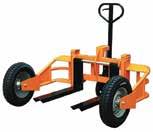

“These homes offer a costeffective and sustainable way to boost housing availability… We’ll just have to see how it goes, but I think we’re off to a good start.”
Liz Cabrera Community and Economic Development Director Petersburg Borough
says. “It’s been a tight market for decades. It was tight in 1980 when my parents moved here.”
Petersburg’s comfortably small population has hardly changed in all that time.
“The school system is excellent,” she says. “I’m on the school board, and when teachers from out of state or other communities move here, they say, ‘Oh this is a private education in a public school system.’”
Petersburg’s low unemployment and crime rates are attractive. “People are able to find jobs,” Holmgrain says. “The biggest concern walking down the street at night might be a bear, not crime. It’s safe. You can leave your doors unlocked. There’s that element of rural living that still exists here.”
Little Norway’s big “but,” though, is the difficulty of finding land to build on that’s connected to utilities. Holmgrain says her father built the family a house as she was growing up, due to lack of other options.
Holmgrain adds, “When I look up licensed contractors with a residential endorsement in Petersburg, there are seven. And of those seven, only a few build new homes instead of just remodels or additions, and one of them wants to retire. We have a lot of do-it-yourselfers in town. I can’t build a 1,200-square-foot house, but I could build a tiny home with me and a friend or spouse.”
When she and her husband moved back to Petersburg, “there was hardly anything to buy or rent,” she says. “Even the rental market has been very tight for over twenty years. If you have a decent house in the $300,000s or low $400,000s, it’s gone within a week. Maybe less.”
Holmgrain sees the PRADU program as a practical solution.
“The tiny home idea is a great option for singles or couples,” she says. “You could have a child in the larger ones, or it could be a downsizing mechanism for those who don’t want to live in a 2,000-squarefoot home anymore but want to stay in Petersburg.”
Funded through the American Rescue Plan Act of 2021 , the PRADU program is one of the first initiatives of its kind in Alaska. While it’s too early to measure its long-term impact, the program has already generated interest among residents.
Cabrera is optimistic. “These homes offer a cost-effective and sustainable way to boost housing availability,” she says. “We’ll just have to see how it goes, but I think we’re off to a good start.”
For residents like Cain, the program represents hope for a brighter future.
“Petersburg is a special place,” Cain says. “The PRADU program shows what’s possible when a community comes together to solve its challenges.”
Cabrera says overall feedback about the tiny home program has been very positive, especially about the designs produced by Cain and Millard. “Many people have mentioned how great they look and would like to get one or two,” she says. “A couple of residents have pulled building permits to construct, but they haven't broken ground yet.”
Cabrera has noticed an unexpected opportunity for more conversations with residents about housing options and what they could do with their property.
Cabrera says, “I recently talked with someone who probably
doesn't have enough space for a tiny home, but then we started talking about what they could do, and now they are considering converting their existing garage int o a small dwelling.”
As Petersburg navigates its housing crisis, the PRADU program serves as a model of innovation and collaboration. By leveraging existing infrastructure and providing accessible solutions, the borough is taking meaningful steps to ensure its residents have a place to call home.
While challenges remain, the program’s success will depend on continued community support, strategic planning, and adaptability.
“At the end of the day, people in Petersburg really care about the future of the community,” Cabrera says. “This program is just one example of how we can work together to make it better for everyone.”
With its focus on small homes and big solutions, Petersburg is proving that even the most remote communities can tackle housing challenges head-on and pave the way for a more sustainable future.
“Housing is a complex issue with no single solution,” Cabrera says. “My hope is this program is one piece of the puzzle that moves us toward better, more attainable housing for our community. Along with other efforts in our community, we will begin make some gains toward expanding the rental market, creating options for young people who would like to live here, elders who want to live closer to family, and homeowners who need another source of income.”

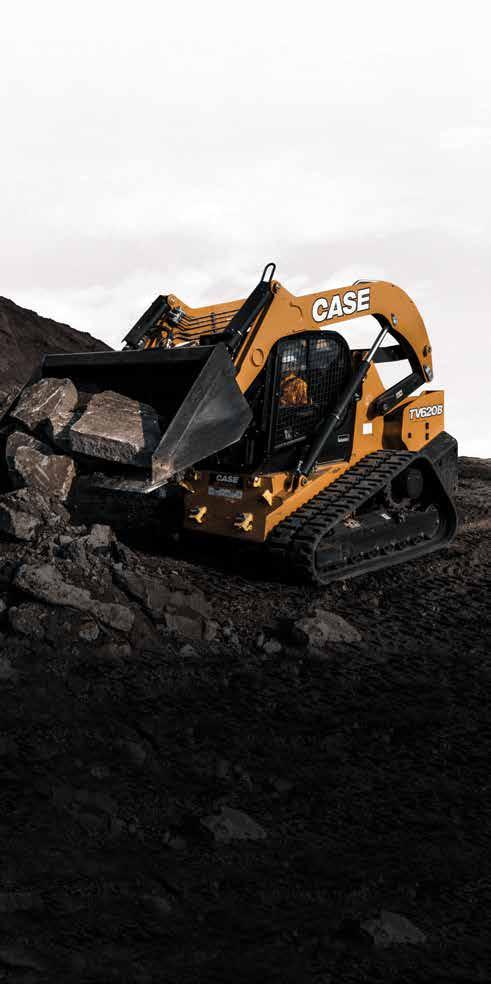
The new fully-loaded CASE TV620B comes standard with an industry-leading package of features. Experience peak performance with best-in-class lift/ bucket breakout force, impressive auxiliary hydraulic power that can handle heavy-duty attachments, outstanding rated operating capacity (ROC), and greater connectivity than ever. Call Yukon Equipment or visit CaseCE.com/TV620B to learn how this powerhouse will help you perform like a rock star on every jobsite.
FAIRBANKS
2020 East Third Avenue Anchorage, AK 99501
Phone: 907-277-1541
Email: info@yukoneq.com
3511 International Street Fairbanks, AK 99701
Phone: 907-457-1541
Email: info@yukoneq.com
WASILLA
7857 West Parks Highway Wasilla, AK 99623
Phone: 907-376-1541
Email: info@yukoneq.com
www.yukoneq.com

By Rachael Kvapil
Fi re protection is one of the most critical, yet inconspicuous, parts of building design that occupants need but hope they never have to use. This essential safety feature is more than alarms and sprinklers. Depending on the type of building, it can exist in ways people wouldn’t recognize. When it comes to fire protection, engineers take a holistic approach to designing a system that ensures the longevity of the structure and occupants inside.
Ounce
Fire protection engineers begin the system design process with one vital question: how do we keep a fire from starting in the first place? This requires a thorough assessment of the project, what Nick Rodes, manager of engineering for NANA Worley, calls
the “hierarchy of hazard controls.”
This hierarchy is a systematic framework of five main components that all engineering disciplines use to increase safety. In the case of fire protection, these components— elimination, substitution, engineering controls, administrative controls, and personal protective equipment— guide the risk assessment before initial systems design.
At the top of this framework is elimination. Rodes says the simplest way to avoid a fire is to remove anything that can fuel one. Elimination includes constructing a facility away from other fire hazards, constructing the facility of fire-resistant materials, and removing highly flammable materials and solvents when possible. This is the main technique for fire safety management.
After eliminating hazards, fire protection engineers look at substitution. Some types of materials, machinery, and products with a medium-to-high fire safety risk will enter a facility. When fire protection engineers can't completely remove a potential hazard, they consider ways to replace the hazard to minimize the risk.
The next step down on the hierarchy is engineering controls. At this level, engineers make physical changes to the workplace to increase fire safety, such as compartmentalizing the hazard or isolating people from risk. Administrative controls have less of an impact than the components above but still can increase safety. Here, engineers assess how people will work together and identify any
process changes that can eliminate an existing hazard. The lowest level of control in this hierarchy, personal protective equipment, is less about prevention and more about minimizing damage by using fire-retardant materials, alarms, and fire suppressants.
“Only after we have figured out how to avoid a fire do we consider ways to alert occupants and stop a fire from spreading,” says Rodes.
Building codes also play a big part in risk assessment, according to Eliot Jordan, fire protection engineering discipline manager for Coffman Engineers. He points out that a hospital will have different fire protection needs than an office building or a North Slope oil and gas facility. Jordan says engineers consider the building occupancy type when they design aspects of a fire protection system. He stresses the importance of thinking of fire protection as more than little red pull boxes, pipes, and sprinklers. Fire protection is about life safety and implementing successful measures through looking at a bigger picture that includes construction, egress pathways, and other protective means.
“We determine what needs protection and then design components that will accomplish that goal,” says Jordan.
Perhaps the most spine-chilling sound one can hear is the blast of a fire alarm. However, Rodes says this is also a good thing because it means the alarm system is working. Alarms are just the start of the process of minimizing a fire once it's started. Fire protection engineers use a mix of different suppression systems,
fire-restraint barriers, extinguishers, and lighting to keep a fire at bay as people exit the building.
When it comes to detection, most people are familiar with the smoke detector. However, a range of detection and alert systems are used depending on the facility. Smoke detectors are generally placed at high points and are triggered by airborne particulates from smoldering fires, while heat detectors measure temperature changes instead of airborne particles. Once a fire is detected, a fire notification device will kick in to alert occupants and others nearby. Notifications can include any combination of horns, bells, chimes, and strobe lights.
A fire protection system is tested prior to turning over a commercial facility to its owners. However, fire protection engineers emphasize the importance of having the system checked annually to ensure it keeps functioning properly.
NANA Worley
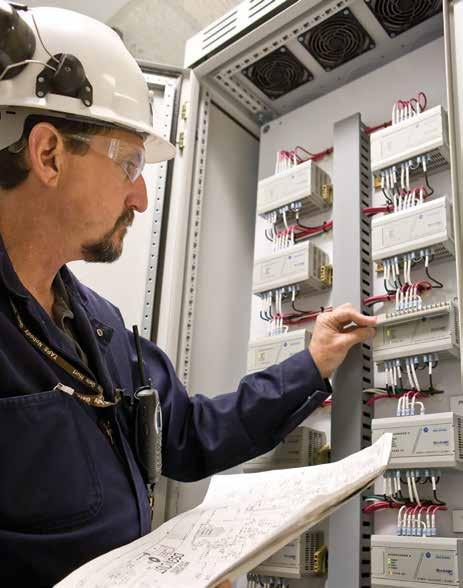
From there, containing and extinguishing the fire is the job of the suppression system. Firewalls and fire doors constructed of fire-resistant materials assist in preventing further spread by sealing off hazardous areas. The size and type of fire will determine the type of suppression method. For instance, fire extinguishers can put out, or at least control, small fires in early stages so long as they’re filled with suitable agents for the type of fire. These portable devices can carry dry chemicals, carbon dioxide, and foam in addition to fire’s oldest enemy, water.
A larger fire suppression system is ideal for fires that can't
“Every facility is different… We direct the installation for that facility based on the conditions.
From the smallest module to a big aircraft hangar, prescriptive solutions need to apply to the project at hand.”
Eliot Jordan Fire Pro tection Engineering Discipline Manager Coffman Engineers
Fire protection engineers use the Hierarchy of Hazard Control to identify prevention and protection methods for commercial buildings. Ideally, engineers integrate the system early in the building’s design.
NANA Worley

be managed with a portable extinguisher. Building-wide systems can release several suppressants, including water, gases, or foam.
Rodes says the primary agent for many suppression systems is water; however, fire protection engineers may choose dry chemicals or some other agent in situations where water wouldn't be appropriate, such as a grease fire, a location where oil or electrical equipment is present, or archival facilities with paper records.
Fire never changes, but techniques for putting out fires continue to evolve. Until the ‘90s, the best choice for building-wide fire suppression, especially where water and electronics would mix poorly, was Halon 1301, also known as bromotrifluoromethane. Widespread use was phased out by 2000 because of the Montreal Protocol, the international treaty to limit production of chemicals that deplete the ozone layer that protects the Earth from the Sun’s ultraviolet rays. These days, gaseous systems use alternatives like nitrogen, argon, or Novec 1230, an exotic chemical sometimes called “dry water” that 3M invented in 2004.
Rodes says the best time to start designing a fire protection system is at the very start of a project. This allows fire protection engineers to work with the design team to create a building layout that allows people to get out safely should a fire occur. He adds that pre-construction is also the optimal time to decide where to place alarms and suppression pipework and fixtures.
“It becomes a big challenge when design professionals leave fire protection until the end,” says Rodes. “I've been invited to projects where 90 percent of the design is already complete before considering fire protection. It becomes difficult to include these vital systems, if left ‘til last.”
Although fire prevention, detection, and suppression technology has advanced, Jordan says engineers still face the challenge of applying prescriptive solutions to a unique situation. Prescriptive designs use pre-defined rules and options to meet their goals. Though there is little variation in the methods and materials used in prescriptive designs, their applications are consistent—which is important when it comes to safety.
“Every facility is different,” says Jordan. “We direct the installation for that facility based on the conditions. From the smallest module to a big aircraft hangar, prescriptive solutions need to apply to t he project at hand.”
All fire protection systems go through a testing process before the building is handed over to the owner. Since it isn't feasible to spray water or chemicals on a newly constructed
building, fire protection engineers have an alternative method to make sure the suppression system is functioning properly. Rodes says they conduct hydrostatic tests on the piping system by filling it with a liquid or gas and pressurizing it for a set amount of time. During that time, engineers look for any leaks that need to be repaired before the system is considered safe for use. Sprinklers are generally not tested on-site; however, they go through extensive laboratory testing and have a successful response record. Once these tests are complete, the fire protection system is ready to alert building occupants if a hazard occurs.
Regular maintenance ensures the system continues to function properly. In Alaska, commercial buildings must test their fire protection systems annually. Depending on the complexity of the system, this includes activating each detection advice, testing the alarm's connection to the containment and suppression system, and, if applicable, checking that all backup power sources are functioning. Rodes says that building maintenance staff are allowed to do a limited amount of work on most systems, but a licensed professional should handle testing and most repairs.
“Frequently, people neglect to test smoke detection systems or disable them if they think they are going off for no reason,” says Rodes. “That is extremely dangerous. Don't assume the system is wrong when it goes off. It might be telling you something about an unseen hazard that needs to be addressed, like a short circuit.”
Though the fire protection codes and standards set by the National Fire Protection Association haven't
changed much over the years, technologies have made prevention and protection systems more efficient. Fine mist suppression systems use a fraction of the volume of water compared to older systems, and Rodes says that engineers in Alaska have a much better understanding of incorporating preventative fire protection methods



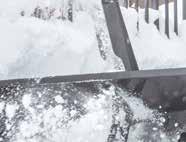


into buildings. Jordan adds that some past materials have proven problematic, which has driven the industry to innovate. Solutions such as firefighting foams and Halon systems resulted in a negative environmental impact, and he anticipates the industry will further evolve as engineers continue to find unique solutions to new situations.












By Vanessa Orr
In summer 2024, a prototype structure was built in Fairbanks using 3D printing to test whether this technology might work in Alaska. A second project, a 1,200-square-foot home, will be built this summer in Nome to incorporate lessons learned from the Fairbanks building while serving as a further testbed.
“While we’re in the research phase right now, we believe that 3D-printed houses could be cost-effective in the long run, particularly on construction projects in Alaska,” says Sven Bilén, co-founder of X-Hab 3D, a Pennsylvaniabased firm that creates robotic
additive concrete manufacturing systems, materials, and designs.
“Using this technology could help with supply chain difficulties, a shortage of labor, and the short building season, all of which makes housing in Alaska two to three times more expensive than it is in the Lower 48.”
Bilén is part of a team of experts who are working together to study ways that 3D printing can help solve
the state’s housing crisis. This team includes UAF, UAA, Pennsylvania State University (Penn State), the Cold Climate Housing Research Center, Xtreme Habitats Institute (XHI), X-Hab 3D, Fairbanks Block and Materials, the Alaska cement masons and plasterers union Local 528, the Innovative Readiness Training Unit of the US Department of Defense, and the National Renewable Energy Laboratory (NREL).
In addition to support from the Denali Commission, the Rasmuson Foundation, the City of Nome, and the Alaska Housing Finance Corporation, the US Department of Housing and Urban
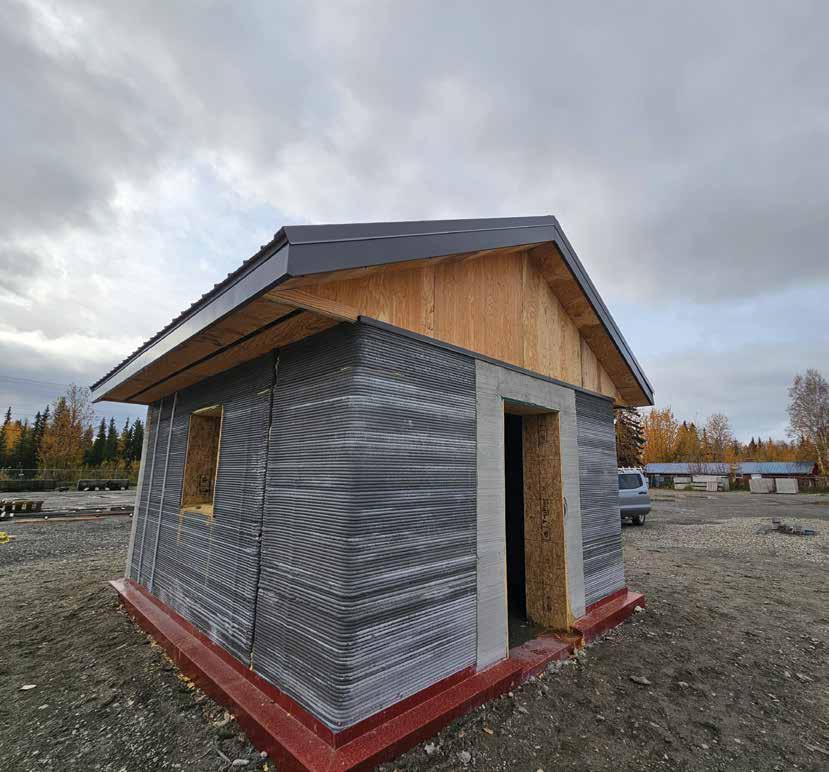
Development (HUD) provided matching funds for the project, including a research partnership grant of $600,000 to the city of Nome.
“We need to think bigger, bolder, and more creatively than ever if we want to build the affordable homes of the future,” said Solomon Greene, HUD’s principal deputy assistant secretary for policy development and research, at a 3D printing demonstration held in Fairbanks last July. “This 3D printer is an exciting representation of this new frontier, and we cannot wait to see it at work.”
To determine if this type of technology has the potential to be successful in Alaska, UAA conducted a six-month feasibility study, including an economic analysis, that determined that the concept had merit. To deal with permafrost issues, a team at UAF worked with the Cold Climate Housing Research Center and NREL to design a special foundation that prevents heat from the house from thawing the permafrost beneath it.
UAF’s Automated Construction and Advanced Materials (ACAM) Lab, led by Director Nima Farzadnia, who also serves as UAF’s lead investigator on this project, focused on using local resources to make the structure both durable and affordable.
“Our goal is to use locally sourced materials so that, instead of relying on imported commodities from the Lower 48, we can rely on what we have in Alaska,” Farzadnia says. “This can include industrial byproducts, municipal waste, seafood industry byproducts, and even the soil here. We conduct research to develop composites using these local materials enhanced with advanced functions.
This could be printability, self-sensing, or self-healing, which are all designed for this harsh environment.”
One of the lab’s goals is to create a product free of portland cement, a material that must be imported from the Lower 48. “Importing construction materials can increase construction costs by up to four times,” Farzadnia explains.
By using automated construction— which can include robotic construction, wireless sensing, or artificial intelligence—ACAM hopes to advance construction methods in the state. Farzadnia notes that robots can also be used for modular construction.
“Robotic construction can play a key role, especially if we merge it with wireless sensors and artificial intelligence, which is how I define automated construction,” he explains. “This could form the future of construction in Alaska, especially in harsh environments. In situ resource utilization (the use of local resources rather than importing them) and automated construction together can provide sustainability and resilience and help keep housing affordable.”
ACAM and NREL monitor the performance of the printed structure over time, which includes job site inspections to look for cracks or other issues. “What we’ve been learning from this Fairbanks building and the lab tests we conduct at UAF and Penn State will provide information that we will fold into the design of the Nome home,” Farzadnia adds.
Materials formulated in the lab are tested in cold rooms for their performance at different temperatures, especially severe cold temperatures, for their robustness.
In addition to testing the durability, the project includes a lifecycle assessment to determine if 3D-printed construction is less expensive than “stick-built” or conventional construction over the life of the home.
“While we don’t have numbers yet, I anticipate that this method will be cheaper than traditional construction for a number of different reasons,” says Farzadnia. “If the ultimate goal of the project is met, we will reduce the importation of certain building materials, including cement, and we will be able to expedite construction using 3D printers, which is very important with respect to Alaska’s short construction season. Labor construction costs should also be lower.”
According to the Research and Feasibility Study on 3D Printed Homes in Rural Alaska, a July 2021 report prepared by the XHI, the time required to print the outer shell of a 1,200-square-foot house—including foundation, walls, and roof—can be as little as 24 hours versus one to four months for a stick-built house. When multiple houses are required in the same area or village, the 3D printer could build one house after another with significant economies of scale.
The study also noted that building the exterior of a house (i.e., foundation, walls, and roof) in Fairbanks with 3D printing would cost an average of $12.97 per square foot compared to $51.38 per square foot using conventional construction methods.
Farzadnia says that one year of research—from the construction last summer in Fairbanks to next summer—will provide performance data to start the next house in Nome. The team will continue to monitor the Fairbanks structure.
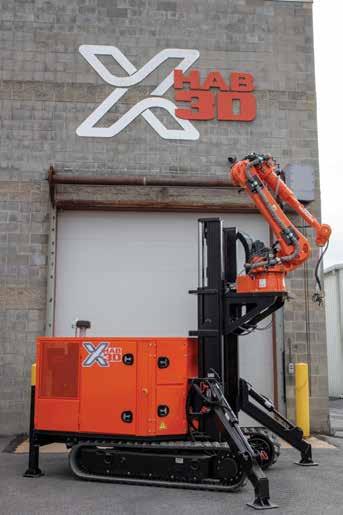


X-Hab 3D developed the fully mobile printer that built the Fairbanks structure and will also build the Nome prototype. The impetus to start X-Hab 3D began when CEO Bruce Kraselsky was working in Alaska on a satellite broadband connectivity project.
“Bruce and several state economic development entities were talking about different challenges to the economic development of Alaska, including the need to provide affordable housing. When Bruce started looking at ways to crack the nut on this issue, he came across 3D concrete printing and wanted to see if it would work in Alaska,” says Bilén. “He looked around for entities and organizations that might be able to help him and found Penn State through its success as part of NASA’s 3D-Printed Habitat Challenge.”
Penn State has an Additive Construction Lab, and X-Hab 3D is its commercialized spinoff.
Penn State’s initial report, which was sponsored by XHI, noted that this technology was worthy of more investigation and could provide a potential solution to Alaska’s housing problem. From that, XHI approached HUD for funds to take research and development to the next level.
“From there, the project continued to grow,” says Bilén.
X-Hab 3D designs, builds, and sells mobile expeditionary 3D concrete printers, which have a number of advantages over gantry-based printers. The Americanmade, mobile, robotic arm-type printers can run on their own power in remote areas. The unit resembles a tracked excavator, but the tool at the end of the arm is a concrete extruder. This style of printer can be set up to print quickly, as compared to days of set-up before a gantrybased printer is ready to print.
“These printers can power the concrete pumps themselves, use water from rain barrels, and can move
over complex terrains,” says Bilén. “If you think about building homes in more remote areas in Alaska, you need to be able to do it without requiring a power grid or water sources.”
The printers can fit inside CONEX boxes or be transported on flatbed trailers. Once in place, they can print structures up to 22 feet tall.
“The amazing thing is that every building can be printed differently,” adds Bilén. “We have design software that allows us to use different shape parameters, so we can customize houses in different designs all within the same—or different—footprint.”
Bilén notes that 3D printers are already involved in many types of construction projects from residential to commercial, and the military has also expressed an interest in the use of this technology. In 2024, for example, ICON used several gantry-type printers to build 100 houses in Wolf Ranch, a community in Georgetown, Texas, making it the world’s largest 3D-printed community.
“We are definitely building on the experience of collaborators in the Lower 48,” says Farzadnia, who has been working in printed construction for five years and
brought the technology with him when he joined UAF.
“While there might have been feasibility studies in Alaska before—I’m not sure—the technology is still pretty new here,” he adds. “And nothing has been done of this caliber, putting together all of these resources in terms of materials design, structural design, workforce development, and more.”
If all goes according to plan, the prototype Nome house will be printed and built this summer, which could completely change the way that future homes are built.
“While there is no one silver bullet to solve the housing problem, this technology is one tool—an important tool— that can help address the issue,” says Bilén. “And it can help not only in Alaska but nationally and globally as well.”
Printed construction is still in its infancy, with materials and techniques evolving in parallel. “The field has made significant advances in the past five years, and it will continue to advance at a rapid pace,” Bilén adds. “I’m excited to see what happens, and I’m looking forward to getting up to Alaska this summer to find ways to provide more quality housing in the state.”
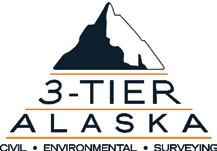
Environmental Impact Statements • Permitting & Regulatory Compliance
Wetlands Jurisdictional Determination Report
Wastewater Treatment System Design & Permitting
Drinking & Storm Water System Design & Permitting

Subdivision Design & Platting • Right of Way/Easements ENVIRONMENTAL
As-built Plot Plans • Boundary Surveys • Road Alignments
Grading Design • Construction
Surveying • Earthwork Quantities/Cross Sections
Cadastral Remote Parcel Surveying • Landscaping & Drainage Design
Water Sample Testing & Analylis • Septic System Design & Testing
Percolation & Sample Analysis • Commercial Site Development
Spill Prevention, Response & Site Remediation
Spill Prevention Control & Countermeasure Plans (SPCC)

One of the highlights of Engineers Week every year is learning more about Anchorage’s outstanding engineers. Nominees for the Engineer of the Year, which honors an exceptional, local engineer, are put forward by professional engineering societies. The criteria to select the Anchorage Engineer of the Year include significant engineering contributions, publications and patents, participation in engineering and other professional organizations, and community service and activities. Alaska Business is pleased to share the 2024 Engineer of the Year nominees; the winner will be announced at the Engineers Week Anchorage banquet, taking place February 22 at the Egan Convention Center in Anchorage.

Anchorage Parks and Recreation Department
Nominated by Society of Women Engineers
Tanya S. Hickok earned a bachelor’s degree in civil engineering from Marquette University in 2000 and became a licensed professional engineer in Alaska in 2005. For the past three years, she has served with the Anchorage Parks and Recreation Department (APR) as a civil engineer, senior park planner, and project manager, leading a wide range of park improvement projects. Hickok has expertly guided these initiatives through every phase, from planning to construction.
As a mother of three autistic children, Hickok is passionate about fostering inclusive play. She combines her love for her family with her dedication to creating accessible play spaces, ensuring that people with special needs have opportunities to thrive. Hickok champions APR’s Play for All program, promoting inclusivity in recreational spaces. For more than ten years, Hickok has focused on park and trail design. She has worked on various planning, engineering, and construction projects throughout Anchorage, including major developments like the Dena'ina Civic and Convention Center and Tikahtnu Commons, as well as significant park and trail upgrades such as the Campbell Creek Trail rehabilitation, South Anchorage Sports Park, and Elderberry Park.

Before joining APR, Hickok spent twenty-one years as a consultant in the architecture and engineering industry. She specialized in project management, site development, land use planning, and permitting. Hickok is also committed to giving back to her community through volunteer and mentoring roles. She has contributed to organizations such as Smart Girls Rock, Engineers Week Classroom Speaking, Anchorage Park Foundation’s Community Challenge Grants, MATHCOUNTS Foundation, Zoning Board of Examiners and Appeals, Institute of Transportation Engineers, and Society of Women Engineers.
Nominated by Society of Petroleum Engineers
Manabu Nozaki is a completions engineer at ConocoPhillips Alaska. He has held various positions in Alaska, Norway, and at the Houston Global Technical
Function, where he supported projects globally (Algeria, Australia, Canada, Chile, China, Indonesia, Norway, Senegal, United Kingdom, and United States) as a subject matter expert on analysis/interpretation of various completion types, post-stimulation analysis, formation failure analysis for completion design, reservoir compaction/subsidence analysis, and tubular stability analysis.
In Alaska, he has been responsible for planning one of ConocoPhillips’ major projects and is currently supporting its execution. He has also evaluated and tested new technologies for the well design and stimulation improvements across the entire business unit.

Nozaki holds a bachelor’s degree in environmental and resource engineering from Waseda University in Tokyo, and he earned his master’s degree and PhD in petroleum engineering from Texas A&M University. He has enjoyed living in Alaska since moving here in March 2021—hiking in summer and skiing in winter with his family.
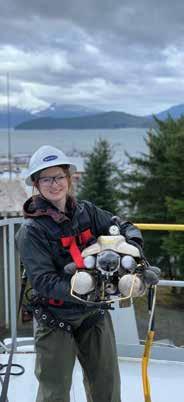
Nozaki devotes his time to professional services: Society of Petroleum Engineers (SPE) conference/workshop program committee (2019 European Stimulation Workshop and 20252027 Annual Technical Conference and Exhibition) and a technical editor (SPE Outstanding Technical Editor Awards in 2014 and 2023) for several SPE journals. He has authored many SPE papers on completions and geomechanics.
Nominated by Society of Military Engineers
Danny Rauchenstein has more than twenty years of experience as a mechanical and fire protection engineer with a significant focus on energy-related designs. He loves collaborating with intelligent, creative people while creating unique, complex solutions for engineering challenges. Rauchenstein is a vice president at RESPEC and manages the business unit. He also leads business development and contract management for facility projects in Alaska and the Lower 48.
Rauchenstein was born and raised in Alaska, which enables him to combine proven knowledge with day-today, real-life experience in cold climates. His expansive

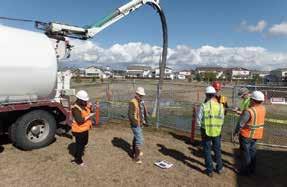
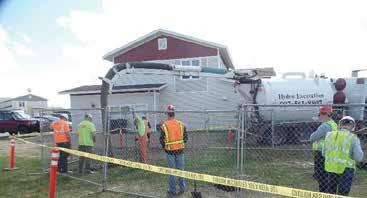


HVAC design experience includes ventilation, heating, plumbing, controls, fire protection, fuel systems, utilidors, and plant design. He also has broad experience in the energy field, including waste heat recovery, oil and gas development, and energy studies. Rauchenstein uses the industry’s newest tools, including 3D CAD, flow modeling, building energy modeling, and economic analysis software.

His unique résumé took him as far as Antarctica to redesign the Amundsen-Scott South Pole Station’s ventilation system. If he can find solutions for a place with temperatures as low as -100°F, elevations at 11,000 feet, and severe winds, he can design facilities anywhere.
Nominated by Institute of Transportation Engineers
Anna Bosin, a UC Santa Barbara graduate with a bachelor’s degree in mechanical engineering, has been
with the Alaska Department of Transportation and Public Facilities since 2008. Becoming a registered civil engineer in 2009, she’s worked across Highway Design, Construction, Traffic, and Safety sections of the agency before joining the Statewide Research, Development, and Technology Transfer (RD&T2) section in 2014. There, Bosin managed diverse research projects, including moose crash analysis, passing lane utilization, and highfriction surface treatments.
In 2016, Bosin was promoted to Technical Engineer II, adding Tribal Relations Liaison to her role. She advocated for rural safety and data-driven initiatives, supporting partnerships like the $2 million federal grant awarded in 2022 for deploying unmanned aerial vehicles in remote communities. In 2018, Bosin spent a year in Washington, DC, as a Department of Transportation Fellow with American Association of State Highway and Transportation Officials, advancing transportation policy, authoring research needs, and advocating for rural and tribal transportation funding.


Returning to Alaska in 2019 to resume her RD&T2 and Tribal Liaison roles, Bosin began managing RD&T2’s $3.1 million annual program, including training and technology transfer under direction. There she pushed for research projects to implement change, including her most recent project: Anchorage Pilot Protected Bike Lane Project, initiated in 2023. Beyond her professional work, she actively volunteers with the Alaska Black Caucus, hosts community conversations, and serves on her local community council. Bosin resides in Anchorage and enjoys taking transit with her 7-year-old daughter, Rae Evora.
Nominated by Institute of Electrical and Electronics Engineers
systems and operations. Ayers holds a professional engineering license within the State of Alaska and is a senior member with the Institute of Electrical and El ectronics Engineers.
In his free time, Ayers enjoys volunteering at Grace Christian School fundraising efforts and is an assistant coach on his children’s you th basketball teams.
Nominated by American Society of Civil Engineers

Mark Ayers, a lifelong Alaskan, has spent his entire career in the telecommunications industry and is currently employed as a telecommunications consultant offering engineering, technology, and business strategy services. His career working in Alaska’s urban and rural telecommunications markets has encompassed all aspects of telecommunications technology and operations. These include the design, implementation, and operation of satellite, microwave, and fiber optic networks; the management of field, engineering, and operations staff; and the development of strategic business plans for corporate stakeholders. Past roles range from individual engineering contributor to holding the position of chief technology officer prior to starting his c onsulting business.
Ayers holds a bachelor’s degree in mathematics from UAA and a master’s degree in electrical engineering from UAF. In addition to his professional engineering experience, Ayers has worked as an adjunct professor of engineering and computer science at the University of Alaska. He taught courses ranging from Network Concepts to Operating Systems and Machine Learning. In 2012 Ayers published the textbook Telecommunications System Reliability Engineering, Theory and Practice as the sole author with Wiley Press, and he is an expert in the field of reliability engineering as it relates to telecommunications
Steven Halcomb is principal geotechnical engineer with Devise Engineering, an Anchorage-based structural and geotechnical engineering firm. Hailing from a military family, Halcomb spent his childhood between the United States and Europe. His family settled in Anchorage when he started high school, and he attended UAA for most of his higher education. He holds bachelor’s and master’s degrees in civil engineering, a master’s degree in arctic engineering, and a graduate certificate in earthquake engineering from UAA, and he has completed numerous graduate engineering courses from Kansas State University and Missouri University of Science and Technology.

Halcomb balances his free time between Alaska life, his famil y, and a good book.
Halcomb works primarily as a licensed and boardcertified geotechnical engineer, supporting civil, structural, marine, and construction engineering projects. He has provided geotechnical and arctic engineering for almost twenty years throughout Alaska, Canada, and the Lower 48 and enjoys helping individuals and communities large or small, urban or rural, with any challe nge they are facing.
Halcomb has actively served in the American Society of Civil Engineers for the last five years as an officer in the Anchorage Branch. He continues his American Society of Civil Engineers service as the vice chair of the Environmental and Public Health Engineering Committee. More locally, he serves as the vice chair of Anchorage’s Geotechnical Advisory Commission while also volunteering in church and schools. He particularly enjoys career days at the elementary and middle schools, where he showcases the fascinating field of geotechnical engineering to eager young minds.




By Rindi White
Th e push and pull between adopting AI as a technology to make everyday tasks easier and putting too much stock in the information AI is providing is real. Case in point: Alaska Department of Education and Early Development staff used generative AI to draft a proposed policy on smartphone use in Alaska schools, and the document failed to disclose the department’s use of AI. What’s worse, some of the AIgenerated content cited nonexistent scholarly articles.
But with appropriate oversight, AI is proving to be a valuable tool, particularly to small businesses where offloading mundane tasks frees human staff to focus on tasks that make better use of their skills.
Ginny Grabowski, an Anchorage business advisor for the Alaska Small Business Development Center (SBDC), says she and other SBDC staff encourage business owners to use AI to help review business plans and assist in finding words to describe big-picture ideas.
“It can break [the process of creating a business plan] down into small, bite-sized pieces for them. It takes the ‘go write the whole section’ of a business plan into ten

questions that they can write one at a time. They can break it down and talk about their business plans in ways that are not overwhelming,” she says.
Not every business specializes in communications, but every business must communicate about itself from time to time. “A company might be faced with providing a company description and they give me a oneword answer. This… helps them express themselves much more clearly,” Grabowski says.
For architecture and engineering businesses, Grabowski says AI assistance can help translate industry jargon into more accessible language for non-industry professionals.
AI can also be useful in finding basic industry data—but users must be meticulous about checking facts. Asking questions such as, “How many architecture firms are in Alaska?” or
“Which area of Anchorage has the highest density of coffee shops?” can help research whether a community has space for the service a business owner might want to provide, assuming the data proves reliable.
“We do also caution our clients that it is AI and it is not always right,” Grabowski notes. “Always check the source. AI can pull from some really terrible sources and from some that
are just not accurate—and it might be pulling from some sources that are not up to date.”
She adds that ChatGPT, a tool released by OpenAI in 2022 that SBDC regularly suggests clients use, should be used as a starting point or to assist with ideas; users should be careful not to just use its responses outright.
She notes that some SBDC clients share their business plan,
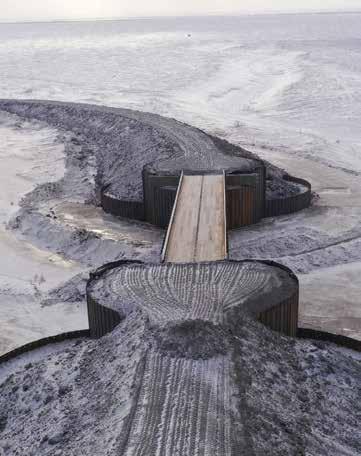

A cross-sectional rendering of the UAF Troth Yeddha' Indigenous Studies Center by Bettisworth architect ChungTse Lin shows how building users might move throughout the center. While AI might be useful in helping count widgets within a structure, it’s not currently up to higher-level tasks such as design.
Bettisworth North

and “it was clear ChatGPT wrote it. There are no specifics.”
SBDC is not the only entity looking for specific details in a business plan. “We have lenders we work with who send clients back and say, ‘This is ChatGPT. You definitely did not write this.’ There are definitely time-saving aspects to AI, but it is definitely not human,” she says. “This is why I think it’s great for kick-starting conversations or kickstarting brainstorming sessions. But for other things, be very careful with what you are quoting.”
For established businesses beyond the planning stages, AI can come in handy in other ways, Grabowski adds.
“When you are a small business owner, everything is a project. Even something like, ‘How am I going to schedule my employees? I have six employees and 45 hours, how can I schedule them?’ Sometimes you don’t have time with a paper and pen to make a schedule,” she says.
In addition to automating administrative tasks or helping to
eliminate jargon in communications, and, Grabowski notes that generative AI can be a useful tool for marketing.
“Especially for doing things you’ve been doing for a long time,” she says, “like a physical fitness business marketing in January, ‘New Year, New You’—we’ve been doing that so many years. Marketing is the bane of small businesses. It can help with that, especially in places where there are no marketing firms. How do you market your small business in your small town?”
The Alaska SBDC is home to the AI Resource Program, which provides several resources, including free white papers, on the SBDC website to help small business owners get started with AI. In 2024, the AI Resource Program launched thirty custom AI tools for business advising and daily operations, with nearly 2,000 uses to date.
The SBDC has also engaged with UAA’s MBA program, which features an AI component, in discussions about AI tools and their potential applications for small businesses to automate tasks, make data-driven
decisions, and improve operational efficiency, ensuring they can thrive in the AI-driven economy.
As interest in AI spreads, many application designers are trying to create apps they hope will be indispensable. Not all of them are, and some are better adapted to one type of industry than another.
Jon McVay, president of the Project Management Institute (PMI) Alaska Chapter, says the organization is “trying to be at the forefront of engaging and integrating AI… without forcing early adoption at the risk of security issues. We’re trying to be responsible for how we integrate it.”
PMI is a global member organization with more than 500 members in Alaska, in industries from hospital project management to information technology and construction.
“If you use project management, we’re for you,” he says. It’s a nonprofit, volunteer-led organization that aims to promote, educate, and
prepare future project managers.
McVay adds, “We have introduction training that varies for members, according to what they want to do. We have our own project management platform that is PMI Infinity.”
The platform, he says, offers an integrated AI tool that allows users to ask questions related to project management. “It tends to be a little more curated for the things that we do,” McVay notes.
McVay says some members have a deeper AI focus: one is writing code that applies to various AI models, enhancing their usability for PMI members. Another introduced them to a user-peer platform that allows users to look at how new AI tools perform.
“That way they don’t have to use the AI to determine which AI they want to use,” McVay says. “Maybe there’s a contract AI that we can run a contract through, and it highlights things that are troubling for the contract.”
There are programs users can use to analyze a proposal in response to a formal request for proposals or tools that can be used for estimating how many items of a certain kind (electrical outlets, for example, or hallway lights in a building) are needed for a particular construction project.
About every six months, the organization holds a membership meeting focusing on AI, offering suggestions for how to apply some of the best AI tools that currently exist, including software that handles tasks such as generating daily project update reports.
While AI’s reach is expanding, architects at Bettisworth North say they are making use of the
technology for outsourcing mundane tasks—summarizing notes, creating meeting agendas—to free up time to spend on the actual architecture portion of the job.
“AI has been helpful in speeding up more rote tasks such as developing agendas and as an initial review of written responses and narratives, but in its current state AI is most useful in a reactionary role rather
than generative,” says Senior Architect David Popiel.
Jack Danberg, a Bettisworth North architect, says industry software is increasingly incorporating AI features, but Bettisworth remains fairly conservative about how it uses them.
“We’re trying to use it to lead to a better service for the client and an elevated product. Our biggest use is helping us with what we would









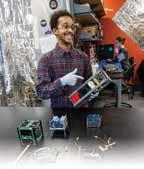





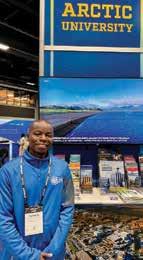
Bettisworth architect Jack Danberg prepared this rendering of the Alaska Railroad Portage Station, which draws on the natural features and “feel” of both the location and its users, factors that AI currently has difficulty incorporating.
Bettisworth North

consider more of the mundane tasks: basic spell check, consistency, tone, messaging. As far as the design side of it, it’s very exciting to see where it’s going, but it’s still early days for that,” Danberg says.
ChungTse Lin, an architect in Bettisworth’s Fairbanks office, says AI is useful in calculations. He and Popiel note that the company can use AI for staffing a project, and for other calculations one might develop using an Excel spreadsheet.
“AI can help with that and make it go quite a bit quicker,” Popiel says.
If the company is designing an energy efficient building that incorporates daylighting— minimizing the need for electrical lighting by incorporating natural light—AI can help calculate what percentage of the outer wall should be windows.
“We’re heading to a time where we can talk to our design software and ask what percentage of my design is glazing,” Danberg notes.
Lin says the tools are not far off— currently, an architect needs to add in parameters and get a response from AI; soon, AI will be able to generate what parameters are needed to make that calculation on its own.
However, skepticism about reliability of data remains. In the “daylighting” example, is AI equipped to understand how little daylight Alaska receives in the winter and incorporate that into the calculation, for example?
“There are so many unique things for designing here, and AI needs to build for that,” Popiel notes.
“Alaska is not just Alaska,” adds Lin. “There’s Fairbanks, Anchorage, Southeast… There isn’t just one design. Alaska is pretty unique; we have very different regions.”
Lin notes that another factor AI is currently not equipped to include is culture, which in Alaska tends to be a significant driver of building design.
The kind of specificity required to incorporate Iñupiat culture into one design and Tlingit culture into another design is currently beyond AI’s capacity.
“It feels like the majority of AI influence is around the edges; find a specific data set you can put pretty good parameters around,” notes Popiel.
But the tools are advancing, Danberg says. Seemingly every new or updated software program is incorporating AI into its design to create a dialog between user and software.
“The big shift, fundamentally, with AI is, across the board, it’s going to revolutionize people’s relationship with software,” Danberg says. “You don’t have to learn to use the tools within a software program; you just need to learn how to talk to the software. We’re not there yet, but there is really some amazing data coming out.”
Bettisworth North, like many other architecture and engineering firms, is actively studying AI to find ways to use the technology to improve efficiency, customer relations, and to perform better as a whole. Employees there have discussed how to engage with and grow AI use, Popiel says. Marketing and Proposal Manager Sue Gillespie says more than three-quarters of the Bettisworth North staff have participated in some sort of AI training, whether at conferences and seminars or elsewhere.
“It’s a firm-wide focus; everybody is kind of excited about it, everyone is intrigued by it,” Gillespie says.
Popiel adds, “AI is here; you have almost a responsibility to understand the impact and engage with it, it’s such a fundamental change.”












• 9.5 air hours from 90 percent of industrialized world
• Handles ¾ of fuel used at Ted Stevens Anchorage International Airport
• U.S. Commercial Strategic Seaport that supports DoD missions around the world
• Interconnects Alaska’s primary marine, highway, rail, pipeline and air cargo systems
Pacific Ocean Seaof Okhotsk Bering Sea
• Handles half of all Alaska inbound fuel and freight – shipped by water, road or air
• Half of port cargo distributed to final destinations outside of Anchorage – statewide
• 90 percent of Alaska residents consume goods shipped across Anchorage docks






By Amy Newman

Ka ty Kless has a passion for marketing.
“I have always had a more creative than analytical mind,” the marketing and communications manager for Ahtna Diversified Holdings, says. “I tell people all the time, ‘I do marketing, not math. I make data look good.’”
Her passion for marketing in the architecture, engineering, and construction (A/E/C) industry, though, happened by chance. In 2010, Kless was a client service and marketing support associate at a local investment firm when she was “lured” into a position with KPB Architects.
“I was enlisted to help often with production of proposals, and from
that point forward I knew I had found my home,” she says. “There isn’t really anything quite like it.”
Kless held communications and marketing positions at PDC Engineers and Coffman Engineers before joining Ahtna in 2021. Her responsibilities are vast and include graphic design, business development, brand management, event coordination, and internal and external communications.
Outside the office, Kless has been an active member of the Society for Marketing Professional Services (SMPS) for more than a decade. The national organization, which has local chapters across the country, is the only professional organization for
marketing and business development professionals working in the A/E/C industry. She’s currently serving a second term as president of the Alaska Chapter, a do-over of sorts for her first term, which began at the start of the COVID-19 pandemic. Kless also serves as a mentor to junior marketers.
The lifelong Alaskan—Kless is an alum of Bartlett High School and UAA—took some time to talk about the important role marketing plays in a business, what makes marketing in the A/E/C sphere different from other industries, how SMPS helps its members stay at the top of their marketing game, and what’s in store for 2025.
This interview has been lightly edited for clarity.
Why is it important for a company to have a marketing plan?
Marketing plans provide focus to support the business or strategic plan. Without a plan, we call that the shotgun approach to business. This means while there might be a target, there really isn’t a focus. Without understanding your goals, how can you target your audience?
What is the difference between marketing in the A/E/C industry compared to other industries, especially those that provide tangible goods?
What is unique about this profession is no one really prepares to do services marketing. It’s not a course in college. When most people think of marketing, they think more of product sales or advertising. We are a business-to-business marketing industry. This means instead of selling a product, we sell our experience as a service to our clients.
Visualize this: a client has a need—let’s say in this instance it is to renovate their building to fit their growing company. That client wants to find the best designer or contractor to do [the job], right? So they inquire about services using the Request for Proposal (RFP), which is likely advertised to the public. This RFP spells out their needs—scope, schedule, and budget. Our design and construction firms seek out this work by reviewing the RFP and aligning their company’s services to best meet those needs. The marketing team works hand in hand with the technical staff to write a compelling proposal to sell our firm as the best company to perform the work. We win the
“No one really prepares to do
marketing. It’s not a course in college. When most people think of marketing, they think more of product sales or advertising. We are a business-to-business marketing industry.”
Katy Kless, Alaska Chapter President, Society for Marketing P rofessional Services

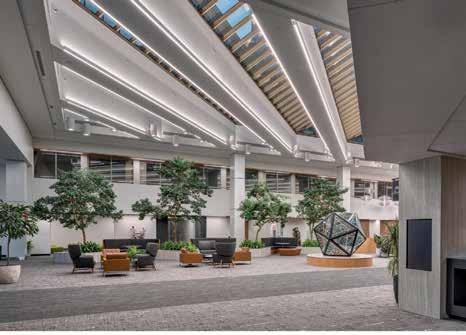
work, the technical team does an excellent job, and now the company has this experience to use to land the next job. That’s the cycle.
Do businesses need to hire a marketing professional, or can they do it alone?
As a marketer myself, I am of course partial to the answer, “Yes,” although in Alaska we have many small companies that quite literally cannot afford the overhead expense of having a dedicated marketer. Many firms have someone who wears multiple hats, such as administration, accounting, human resources, and marketing, or a technical person doing any or all of the above. If that is the case, it is even more reason to get involved with SMPS. We are the only resource for industry-specific training and trends in marketing.
What should a company consider when looking for a marketing professional, whether they are looking to hire for an in-house position or an outside agency?
A marketer with all the experience you need can certainly feel like a “unicorn” find. While you may not find the perfect fit to just take the ball and run with it, do not overlook the power of the right fit for your firm in a candidate who has good writing skills and is self-driven. Also, you could consider candidates from outside Alaska. This is something positive that COVID has given us. We realize now that remote workers can open all sorts of possibilities.
If your firm is looking for a marketer, SMPS does have a job board to post your open position; it’s free for members, or there’s a small fee for non-members. If you need help crafting a job position, reach out; we can help.
What drew you to become a member of SMPS?
Shortly after starting in this industry, it was suggested that I join and get involved with SMPS. After joining the association, I quickly realized how incredible it was to have a resource that was specific to marketing in the A/E/C world. I joined a committee to get more involved and that was it. Ten years have gone by, and I stay involved because of the people, the education, and the opportunity to give back to the organization that helped build me as a marketer.
How does SMPS keep abreast of best practices and what’s new in the marketing world? How does it share that information with its members?
Well, that is one of the great things about SMPS: we learn from each other. Outside of our local chapter in Alaska,
there is a wealth of knowledge and resources nationwide with other chapters. Many of us travel to conferences outside of Alaska for opportunities to pick up new skills and learn trends coming because we all know Alaska is behind a few years in trends. Each year there is a Pacific Regional Conference for SMPS that varies in location. [The 2025 conference took place January 29-31 in Palm Springs, California.] Additionally, there is a national conference called Amplify that many of us attend to learn and grow.
We all strive to bring that knowledge back to our firms and share it with our peers. Often our attendance at these conferences leads to our chapter building programming for our members and eventually bringing up speakers from Outside to invest in our membership growth.
What type of events and training opportunities does SMPS organize for its members?
SMPS Alaska hosts events monthly. All our events have special member pricing but are open to all non-members as well. Generally, we do a business development-focused luncheon that usually offers a panel of client/owner(s) focused on a specific topic with the intent to build business. We also offer a virtual marketing-focused training monthly with varied topics, from proposal development to what tools to use for efficiently doing your job. We send a weekly newsletter on Thursdays. Be on the lookout or reach out if you want to be added to our mailing list.
What other benefits does SMPS offer its members?
How do I count the ways? As with any membership, you get out of it what you put into it. There are a large number of benefits that many might not know about or use, like our resource center, MYSMPS, our exclusive SMPS magazine, Marketer, and nationwide resources. I would say that the moment that I joined a committee back in 2013 was pivotal to my career development. So jump right in.
If you are not a member, I encourage you to reach out to membership@smpsak.org to find out more. If you are already a member, you should reach out to me at president@smpsak.org to find out how you can be more involved.
What new events, initiatives, or projects are coming up for SMPS Alaska in 2025?
Coming soon we are planning a signature event on artificial intelligence and how we can use it in this industry to be better at our jobs and stay efficient. Be on the lookout for exciting events in the new year.
If you had one message for our readers, what would it be?
Be curious. Do you have a desire in a specific area, business or personal?
Let SMPS help you develop that area. Be engaged. If you are a member already, use your membership to its fullest.

“The marketing team works hand in hand with the technical staff to write a compelling proposal to sell our firm as the best company to perform the work. We win the work, the technical team does an excellent job, and now the company has this experience to use to land the next job. That’s the cycle.”
Katy Kless


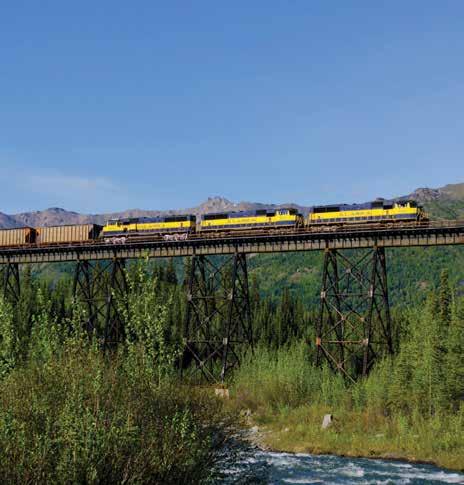
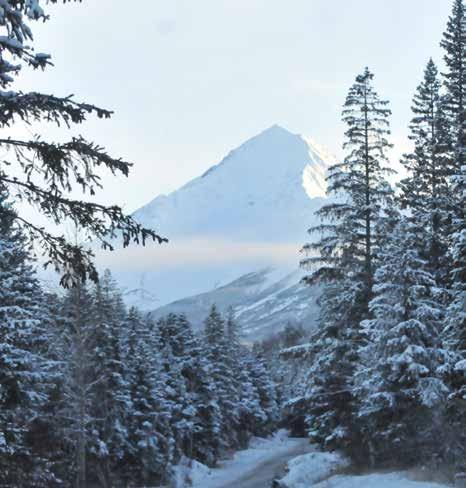
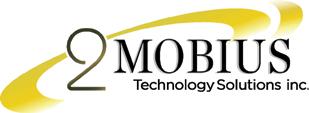
By Vanessa Orr
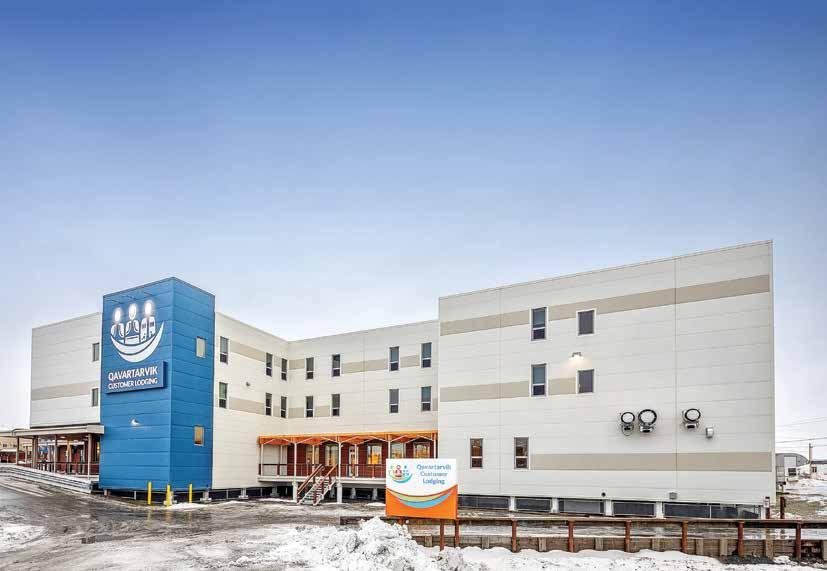
Wh ile Alaska creates a challenging environment in which to build, Design Alaska’s knowledgeable, experienced, and deliberate approach, especially on projects in the Interior and far north, ensures that the building envelope, foundation, and mechanical systems will function for at least forty to fifty years without major repairs or restoration.
According to Jeff Putnam, vice president of the Fairbanks-based firm, this level of expertise has enabled staff to work on a variety of unique projects. These include the new $30 million transit center for the Fairbanks North Star Borough (FNSB), which will provide storage, maintenance, and a fueling station for buses being converted from
diesel to compressed natural gas, and the Qavartarvik Customer Lodge, a patient lodging facility in Bethel for the Yukon-Kuskokwim Health Corporation (YKHC).“The customer lodge is such a neat and beautiful building, and it was a ton of fun for our staff to work on,” says Putnam. “Our architects and interior designers got to express their design creativity in pulling it all together.”
The 109-room facility will enable people in the region to fly into Bethel for medical treatment, giving both patients and caregivers a home away from home.
“Design Alaska answered the call to come up with a unique structural design,” says YKHC Director of Construction Kris Manke of the space that includes cultural aspects of the
Yukon-Kuskokwim region. “Their design proposals were excellent— and their teams are responsive and easy to work with.”
YKHC and Design Alaska have also worked together on the Ayagnirvik Healing Center, a treatment center, and Bautista House, a residential home. Manke notes that the firm’s multidisciplinary team was especially helpful during the construction period, with in-house support allowing for strong coordination throughout the project.
“We appreciated that they provided the full range of services, from design to construction administration and closeout,” he says. “And they were quick to respond to questions and issues and worked with YKHC and the contractor to help resolve the
few issues that came up during and after construction.”
Since its start in 1957, Design Alaska has gone through a number of iterations. It was originally named after founders Les Rogers and Bob Gray before being renamed as Design Alaska in 1985. Now the largest fullservice architectural and engineering firm in the Interior, the company provides clients with expertise in architecture; civil, structural, mechanical, fire protection, electrical, control systems, and environmental engineering; landscape architecture; and land surveying.
“While some architectural and
a professional engineer. “We’re unique because we are able to provide a complete solution for someone looking to design a new building or renovate an existing building; we have all of the services here together and can pull them together efficiently.”
According to Putnam, one of the advantages of working with the company is that its multidisciplinary approach provides a more seamless process for clients.
“We all go into the conference room together, in person, and talk through how to approach a project,” he says. “Our teams also use the latest software and technologies that allow us to build accurate 3D models
be updating a floor plan, and the mechanical and electrical engineers can access and react to those changes immediately.”
The result, he says, is an efficient, well-coordinated, high quality construction document.
Design Alaska’s fifty-five employees finish roughly 125 to 150 design projects a year. This capacity is especially important for school districts or government agencies that advertise multimillion dollar projects within a short time span to meet strict funding and construction schedules.
Because staffing is so robust, construction documents undergo peer review internally, ensuring that the company generates




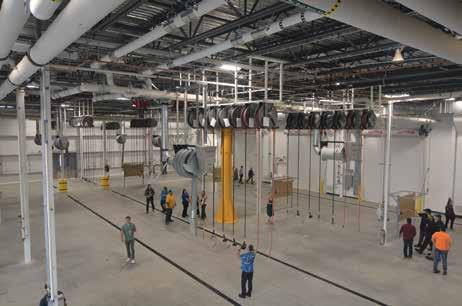
throughout construction, performing progress inspections and providing continuity that results in high-quality construction work that meets the intent of the original design.
Not only does Design Alaska work hard to serve its clients, it also believes in supporting its employees. In addition to offering very competitive benefits and highquality workspaces, it provides little “extras” such as vegetable trays and fresh fruit bowls two times a week as part of its wellness program.
More importantly, if an employee is interested in expanding their career options, the company encourages their efforts.
“Whether a team member wants to earn a new certification in cyber security, wants to specialize in medical facility design, or is curious about becoming an energy auditor, we support them in their areas of interest,” says Putnam. “We also provide opportunities to work on a wide variety of projects in order to make this a rewarding professional experience.”
Employees enjoy the challenge of taking on and learning new things on projects that they have previously not encountered, in Putnam’s view.
Josiah Alverts has been an engineer in training in Design Alaska’s Mechanical Engineering Department for the past three years and has worked on projects ranging from light commercial facilities to military base installations and industrial developments on the North Slope.
“Because of the variety of projects Design Alaska does, I knew that it would expose me to a lot of different things as a young, developing
engineer,” says Alverts, who joined the firm as his first job out of college.
“I wanted to work here because I believed that Design Alaska had very high standards and a company culture that promoted designing the right project for each individual client—and three years later, I can say those impressions were right.”
Five months after joining Design Alaska, Production Assistant Brandy Kauffman is also forming a favorable impression.
“I had a pretty picky checklist
for myself when choosing where I was going to work, and I knew very shortly into my interview with Design Alaska that my search was over,” she says. “I knew right away that Design Alaska was (and still is) a company run with old-fashioned morals and employee support, and one that had successfully evolved with modern ideals without losing core values in the process.”
Kauffman describes the environment as a cohesive blend of fun and professional. She says, “That
aligned with my personality and personal values, so as soon as I got the offer, I accepted!”
Kauffman notes that Design Alaska has “practically unlimited” potential for career advancement and hires and promotes internally as much as possible.
“As an admin employee, I can choose to cross-train, working toward being able to go out with the survey crew to do hands-on site visits, or learning how to design projects—whatever I want to try,”
“We’re unique because we are able to provide a complete solution for someone looking to design a new building or renovate an existing building; we have all of the services here together and can pull them together efficiently.”
Jeff Putnam, Vice Pres ident, Design Alaska
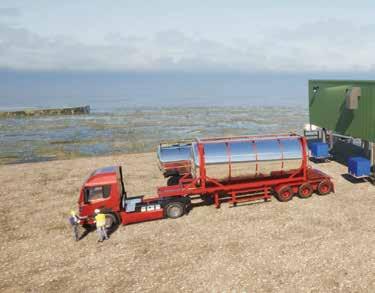

“Whether a team member wants to earn a new certification in cyber security, or wants to specialize in medical facility design, or is curious about becoming an energy auditor, we support them in their areas of interest… We also provide opportunities to work on a wide variety of projects in order to make this a rewarding professional experience.”
Jeff Putnam Vice President Design Alaska
she says. “I could also go back to school, and Design Alaska will help me pay for credits.”
She adds that the company’s efforts to stay involved in the community also swayed her decision. She appreciates that the company integrates community involvement opportunities into dayto-day work while ensuring that employees are aware of additional opportunities as they arise.
“One of the things that Design Alaska has been doing for many years is making a concerted, deliberate effort to support arts in the community,” says Putnam. “One of the surprising benefits of this is that, when interviewing new employees, they often talk about how they are impressed by Design Alaska’s commitment to the community and that it’s one of the things that attracted them to our company.”
For decades, Design Alaska has supported both nonprofit groups and events, including the Fairbanks Symphony Orchestra and its holiday concert, the University of Alaska Foundation, the Fairbanks Concert Association, the Fairbanks Drama Association, KUAC TV 9/FM 89.9, the United Way of the Tanana Valley, Greater Fairbanks Chamber of Commerce, Green Star, and the Fairbanks Economic Development Corporation. The firm is also the title sponsor of the Design Alaska Wild Arts Walk, a midsummer artists’ market at, and for the benefit of, Creamer’s Field Migratory Waterfowl Refuge.
According to KUAC General Manager Gretchen Gordon, Design Alaska has provided support in several ways. Underwriting public broadcasting via music programming sponsorships
showcases a love of the community.
“These sponsorships made it possible to create a live music showcase of Alaskan and visiting musical artists and to create a curated New Year's Eve request program during the [COVID-19] pandemic when people were isolated at home and unable to ring in the new year with friends and family,” she explains.
“Design Alaska's staff has served as both leadership and talent volunteers for KUAC and has even partnered with other businesses to challenge the community to give generously during our on-air fundraisers. Design Alaska has been an integral part of KUAC's success.”
As a result of its nearly two decades of support of KUAC’s Alaska Live series, which brings Alaskan and visiting musical artists into KUAC studios for live music and conversation, the radio program developed into a hit television show.
“Design Alaska leaders have served on our leadership council, as volunteers on air during our on-air fundraisers, and have been champions of the public broadcasting mission furthering our reach in the communities we serve,” adds Gordon. “They jump in eagerly to assist when they see a need in the community that needs to be met. Their leadership leads by example and encourages employees to get involved in community activities and nonprofit organizations that have a locally focused mission. The love, compassion, and dedication to our community that Design Alaska possesses is quite apparent.”
Beyond high-profile efforts, Design Alaska spreads its community support further with smaller, staff-g uided contributions.
“Provided we are in the right financial position at the end of the year, one of neat things we’ve done in the past three or four years is to let each employee pick a nonprofit in the community in which they live, and we give $500 on that employee’s behalf to that group,” says Putnam. “This is in addition to all of the other programs we’re supporting t hroughout the year.”
In recognition of its efforts, Design Alaska has received numerous community awards including the Small Business of the Year and Outstanding Business in Arts from the Greater Fairbanks Chamber of Commerce, the Green Star Award for Environmental Consciousness, Youth Friendly Business from Spirit of Youth,
Education Commission, and the Outstanding Small Business in Philanthropy from the Association of Fundra ising Professionals.
More important to Design Alaska than the awards, as Putnam sees it, is the trust and respect that it has earned from its clients and the community. “While we do appreciate the awards, that’s not a priority for us,” says Putnam. “We just do our business and go on t o the next project.”
As the saying goes, doing good work is its own reward. “We’re proud to have a lot of repeat customers and to have established good relationships over the years,” Putnam adds. Those repeat customers include the US Bureau of Land Management,
District, UAF, and the FNSB. Their continued confidence speaks for itself. Putnam says, “This is what ’s important to us.”
New projects that Design Alaska currently has in the works include an Avis car rental facility carwash, a community center in Solomon, an accessible playground in Pioneer Park in Fairbanks, and the design of new Fairbanks subdivisions. It is also working on numerous code upgrades for fire suppression systems, housing improvements in Minto, modernizing the Fairbanks Youth Facility, renovating dorms and hangars on local military installations, and a drift boat retrieval system for Kenai, among others.
“Every one of these projects is unique and fun and challenging in its own way,” says Putnam.






By Tracy Barbour

Al yeska Tire, a prominent business in Alaska’s tire and wheel industry, is expanding its presence, vision, and impact with the construction of a state-of-the-art retail location in Soldotna. The 7,200-square-foot, tenbay facility positions the company to start 2025 with enhanced product offerings and services.
The new facility sits strategically next to Alyeska Tire’s current site on the Kenai Spur Highway. Aside from a few “hiccups here and there,” construction has gone “rather smoothly,” according to coowner Craig Wortham.
“Planning the right of way and getting approval was a little frustrating,” he says. “Otherwise, LittleKnife [construction company] has made the entire project relatively easy for us.”
Alyeska Tire hired two extra people because of the Soldotna expansion— and to support the company’s longerterm plans to expand its footprint in the Alaska market while serving as a model for sustainable operations and investment in renewable energy.
Alyeska Tire first expanded to Soldotna in 1989. However, its service to Alaskans began long before then.
The business was co-founded as “Alyeska Sales and Service” in 1978 by Jerry Wortham (Craig’s father) and the late George Navarre. The partners purchased a Chrysler dealership with the idea of selling used cars and auto parts. The business grew, and Jerry Wortham bought out Navarre’s half. In the early 2000s, the company’s name was changed to Alyeska Tire to better reflect its key focus: selling tires.
Now under the husband-and-wife team of Craig and Bethany Wortham, Alyeska Tire boasts eight facilities throughout the state. The dealership’s operational footprint features a distribution center, a truck tire center, and six retail locations. With a presence in Soldotna, Anchorage, Fairbanks, Kenai, Palmer, and Homer, Alyeska Tire offers a broad selection of tires and wheels, along with comprehensive maintenance services, ranging from tire changeovers and brake repairs to engine diagnostics and preventative maintenance.
Alyeska Tire’s recent expansion in Soldotna is expected to have a significant effect on the Kenai Peninsula. Increased inventory capacity and allows Alyeska Tire to serve a larger clientele. Additionally, the company will be converting the old building into storage for the new
location next door. The construction project has already created several new jobs, and more opportunities are expected as Alyeska Tire continues to expand throughout the state.
As part of Phase 2 of the expansion, Alyeska Tire is planning to add electric vehicle (EV) charging stations.
“We anticipate that we will be able to introduce this to the public free of charge at the onset,” Bethany says. "We believe that the future of our industry will be dictated by electric vehicles. We want to be leaders, not followers. We want to inspire.”
Industry trends indicate that the future of transportation is electric. The EV market is rapidly evolving, with models available in a range of vehicle types, from compact cars and sedans to sport utility vehicles
and pickup trucks. The federal government has set a goal to make half of all new vehicles sold in the United States in 2030 zero-emissions vehicles, according to the US Department of Transportation (DOT).
Alyeska Tire plans to install EV chargers at all its locations. The company recently added two at its Palmer location and is exploring a potential partnership with a firm that has conducted extensive analysis of chargers in Alaska's extreme temperatures.
“As our world changes, we want to be a part of that change,” Craig says. “We are looking into a company [FLO] that has done substantial research and testing in Fairbanks— specifically testing the chargers in extreme temperatures ranging from -40°F to 122°F. The company uses aluminum to reduce corrosion and
“Clean energy investments are booming, driven by industrial policies and market demand… This attracts further investments and boosts economic growth. We are trying to nudge Soldotna and Alaska forward.”
Craig Wortham Co-owner and General Manager Alyeska Tire

Scheduling a Business Profile in Alaska Business magazine or a Spotlight Digital Profile on akbizmag.com offers businesses an excellent way to enhance their visibility and strengthen their credibility with decision-makers in Alaska. These advertising formats effectively reach a targeted, professional audience while building lasting brand recognition. Our print and digital platforms are trusted sources of information for decision-makers, entrepreneurs, and industry leaders across the state. By investing in a full-page Business Profile, your company can reach a highly
relevant and engaged audience—one that is actively seeking solutions and interested in your business.
A Spotlight Digital Profile on the Alaska Business website is equally impactful and has SEO value. The digital platform draws visitors looking for local businesses, service providers, and industry insights and allows you to enhance your online presence in an increasingly digital world.
Position your company as an authority in your field. Readers view businesses featured in the magazine as credible and established.
A well-crafted profile lets you share your company’s story while highlighting what makes your business unique. Business Profiles are a powerful medium for brand recall. The magazine is widely distributed across the state and is often found in waiting rooms, offices, and public spaces, meaning it has an extended life beyond the initial read.
In the digital realm, a Spotlight Profile
provides similar benefits. Our spotlights page is sleek and professional and encourages engagement. It enhances your presence on our website while tapping into a global audience through search engine visibility.
The Business Profile option includes professional copywriting and photography as part of the package, reprints, and a wall plaque, providing value beyond the printed and digital magazine.
Ultimately, the print and digital advertising options available through Alaska Business offer businesses a powerful way to increase visibility, build credibility, and connect with an influential audience.
Call or email us if you are ready to discuss how a profile could benefit your business.

Charles Bell Vice President of Sales & Marketing 907-230-8213 | cbell@akbizmag.com


has a unique heating and cooling system. We’d like to partner with a company that understands the challenges Alaska presents.”
Alyeska Tire's new retail location is designed to promote energy efficiency and sustainability. For example, the building incorporates features that reduce energy consumption and improve air quality. “We invested in higher R-value doors and utilized ‘smart door’ technology to be more efficient and consume less energy,” Craig says. “We have low-energy lighting—anticipated to save 50 percent on energy—and a modern HVAC system that recirculates air.”
Air handling is especially important in auto-servicing spaces. “Tire shops get extremely dusty, especially in the spring and summer. We are looking forward to good air quality in that
facility and hope to install units like this in our other locations,” Craig says. “As well, the HVAC system has the capability to provide air conditioning; it seems each summer that becomes more and more desired as we deal with a changing climate in the North.”
Looking ahead, Alyeska Tire is contemplating the creation of a separate entity to underscore the company’s long-term vision to lead in sustainable practices and contribute positively to the community and environment. “We are currently hoping to do a spin-off company solely dedicated to the promotion of renewable energy,” Craig says.
For such an effort, Soldotna is a fine starting point. The local power utility, Homer Electric Association (HEA), operates the state’s largest renewable energy facility, the Bradley Lake Hydroelectric Project with 120 MW of installed capacity. HEA signed
a purchase agreement last August that enables Renewable Independent Power Producers to build a 30 MW solar farm, the Puppy Dog Lake project in Nikiski, which will be the largest in Alaska to date.
In Soldotna, HEA installed Tesla Megapacks to demonstrate gridconnected battery storage under Alaska weather conditions. And Soldotna is where the state’s first Tesla Supercharger was installed, hosted by Addie Camp at Whistle Hill, a business that also wants to be at the forefront of the EV transition.
From solar panel technicians to wind turbine engineers, the demand for skilled workers in the renewable energy field is growing, driven by the global shift toward sustainability, Craig says. “The industry is innovative, constantly evolving, and offering
numerous opportunities for research and development roles,” he adds. “We encourage change and adaptation.”
The transition to renewable energy is not just about environmental sustainability; it also fosters economic advancement, according to Craig.
“Investing in renewable energy is a powerful driver for job creation,” he says. “The renewable energy sector is booming, and it's creating a wide range of job opportunities.”
Studies show that clean energy investments create more jobs per dollar invested compared to fossil fuels, Craig emphasizes. “These jobs contribute to long-term economic stability and growth,” he says.
“Reducing reliance on fossil fuels helps mitigate climate change and pollution, leading to longterm environmental and health benefits. Diversifying the energy mix enhances energy security by reducing dependency on fossil fuels.”
Craig says transitioning to renewable energy can reduce wholesale electricity costs by 20 percent to 80 percent in the medium term, depending on the region. This can lead to increased profitability for firms and upward pressure on wages. “Clean energy investments are booming, driven by industrial policies and market demand,” he says. “This attracts further investments and boosts economic growth. We are trying to nudge Soldotna and Alaska forward.”
The company’s decision to invest in the new facility is deeply rooted in the community’s backing of the project.
“We have received unrivaled support from the residents there,” Craig says. “Without Soldotna’s investment in us, we would not be where we are today. We feel it is important to say ‘thank you’ for your support.”




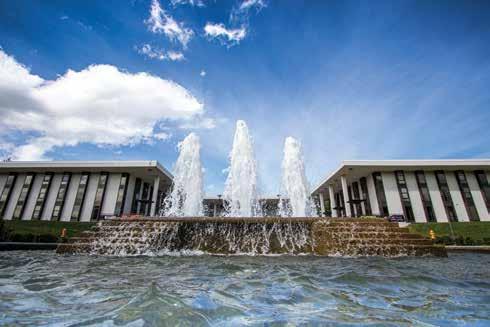
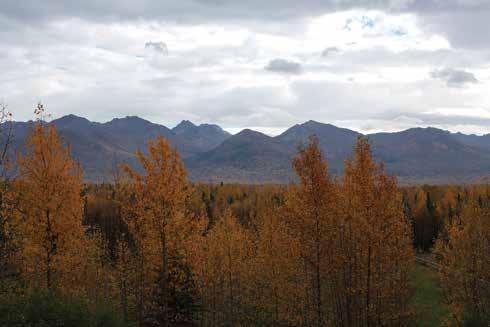
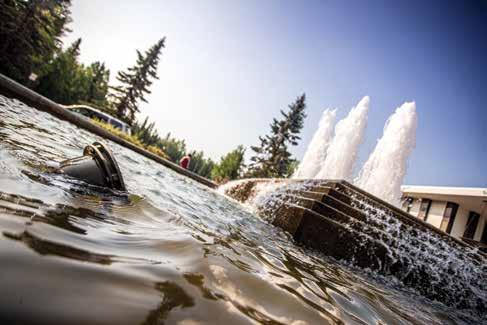











































By Alexandra Kay
Ve hicles outnumber the Alaskans who drive them.
According to the Division of Motor Vehicles, all registered vehicles in the state amounted to 808,874 in 2023 (the latest year with complete data). The state’s population, of course, has yet to exceed 800,000, pegged at about 733,000 during the last census.
Passenger cars and pickup trucks add up to 601,684, which is more than the number of driving-age Alaskans. How did they all get here?
Either the owner drove into the state personally, or the car or truck was purchased from a dealer that had it shipped in. Or the third option: those wheels arrived thanks to a vehicle shipping company.
Wrightway Auto Carriers is an Alaskan-owned company that’s been in business for more than seventy years. According to General
Manager Paul Carson, braving the Alcan is not the best way to bring a car into Alaska.
“We only have one highway into the state, and it’s a long, challenging highway to make it up, so the majority of vehicles that come into the state on a new or used front come in over the water,” says Carson. “The Alaska Highway is a challenging trip and it’s very hard on vehicles, so it makes sense to ship your car and have us deliver it to wherever in the state.”
With Wrightway, says Carson, most vehicles are loaded at the Port of Tacoma in Washington and travel by carrier ship to the Don Young Port of Alaska in Anchorage. In addition to transporting cars, trucks, travel trailers, and more for people moving to and from Alaska, whether for corporate, military, or private reasons, Wrightway also handles the logistics for many dealerships within the state.
“Vehicles come into the state on an ocean carrier, and once they reach
the port, we deliver to a significant number of dealerships in the state as well as other customers— like oil companies up on the slope in Prudhoe Bay.
If the vehicle is going to someone within the Anchorage area, it may be picked up at the port or Wrightway may deliver it to the customer’s door.
If a vehicle is going farther, say to Fairbanks or Kenai, it’s then trucked to its final destination, which can also be challenging. “Within the state, with our trucking, weather and road systems are a challenge up here,” says Carson. “Just going from Anchorage to Denali to Fairbanks, you’ll run into every type of weather on the way: ice, rain, snow. There are ever-changing and evolving road conditions.”
The tough conditions are why Carson suggests leaving vehicle transport to the professionals. Many shipping companies will ship a vehicle with personal belongings inside, which can cut down on moving costs.
And it’s not unheard of for vehicles on the 1,400-mile Alaska Highway to have breakdowns and need repairs, so a well-maintained hauler can avoid those costs as well.
Simply driving a car or truck home is not an option for the 86 percent of Alaska communities not connected to the road system. Vehicle transport to those destinations is a job for a specialist.
Bowhead Transport, a subsidiary of UIC Commercial Services, specializes in providing “exceptional marine services in the most challenging environments.” Bowhead delivers vehicles by barge to some of the most remote communities in Alaska. “The only way to deliver is by barge,” says Bowhead Vice President Chris Palle.
Just because towns and villages are off the road system doesn’t mean cars and trucks are unwelcome. Residents need wheels to haul supplies and run errands on local streets (not to mention trailers, allterrain vehicles, and snowmachines).
Vehicles drive around plenty once they reach their destination, even when driving there in the first place is not an option.
“There are some communities on the North Slope that have ice road access in the winter, such as Barrow,” says Palle, “but the majority of the coastal communities in western Alaska, the Aleutians, and the Arctic area are barge access only for supplies.”
In a way, vehicle transport is even more urgent in communities without smoothly paved streets. “The road conditions associated with using the vehicles is hard on them, so they get replaced frequently,” says Palle.





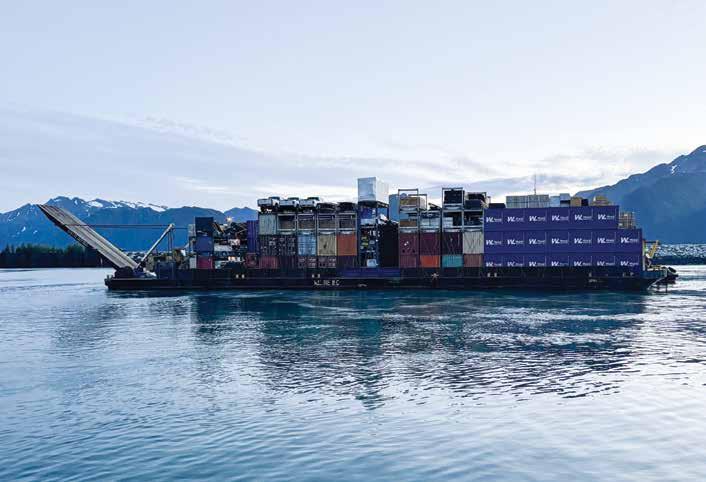
“As a result, providing transport of the vehicles to those communities is extremely important to the residents who live there.”
Bringing vehicles ashore is not easy. “Some of the locations are exposed to open ocean, either the Bering Sea or the Arctic,” says Palle, “and because of this the conditions have to be just right to land a 300-foot barge on a sandy beach. So watching the weather and sea conditions and timing those deliveries correctly is extremely important.”
Once up to the beach, getting off the barge is its own challenge. “Once we do have the ramp down to drive the vehicles or carry the vehicles off the barge and carry them to their new owner, sometimes there is soft sand, gravel, rocks, cobblestone. So each and every location requires a different set of supplies and
equipment to safely deliver those vehicles.” Bowhead solves these issues by building portable roadways, using graders to compact base material, utilizing heavy equipment to carry vehicles, and more.
“I think that these types of deliveries are very unique to the Alaska region,” says Palle. Most places might have barge docks or landings already built, but that’s not always the case in the areas that Bowhead services. “Logistically, these types of deliveries in the state of Alaska are typically more challenging than most locations outside of the Lower 48.”
Bowhead Transport approaches every project by determining how, not if, it can be completed. Palle says the company’s motto of never using the word “impossible” speaks to this.
Bowhead Transport needs to schedule around the ice that covers the Arctic coastline for a good portion of the year. For example, says Palle, shipping a vehicle from Seward to Nome must wait until after June 15. Shipping a vehicle farther north to Utqiaġvik can’t happen until after July 25. To get one from Utqiaġvik to Prudhoe Bay, transporters have to wait until about August 10 before the ice clears (although the Dalton Highway is an overland option).
On the opposite end of the calendar, the Arctic begins to ice over around October 1, and the ice will work its way south until the ice covers the northern portion of the Bering Sea and Norton Sound area. “A lot of people think about barging in Alaska as a seasonal business, but it’s not a seasonal business,” says Palle. “Each region has its own unique challenges throughout the entire year. Seward,
Dutch Harbor, and Anchorage are all accessible all year long, and business does continue. The Alaska Peninsula and the Aleutian Islands are all year-round locations, but other places are not.”
Another challenge can only be expected, not planned for: wildlife. “Sometimes we have to raise the ramps on the boat to make sure the polar bears don’t climb up onto the boat,” says Palle. “There are lots of safety precautions we have to take to protect our crew from polar bears. They’re curious and want to just get on board and take a look around. When that happens, the whole crew just goes inside and watches them walk around the deck and then eventually they leave and jump back in the ocean and go.”
Polar bear and walrus encounters are worth the risk. Palle says, “Providing transport of the vehicles to those communities is extremely important to the residents who live there. If you’re a receiving customer in one of these small coastal communities of about 100 to 200 people, when a barge pulls into town if you’re waiting for your vehicle, you’re probably going to walk down to the landing to see your vehicle come off that barge. A barge delivery is a big deal because it doesn’t happen all that often.”
Even on the road system, vehicle transporters provide a valuable service to Alaskans. Of Wrightway, Carson says, “We are locally owned and staffed and have been around since 1950. We’re a group of dedicated Alaskans here to support Alaskan businesses and the public to ship their vehicles. It’s challenging to do, and we try to make it easy for everybody and support the community in doing so.”







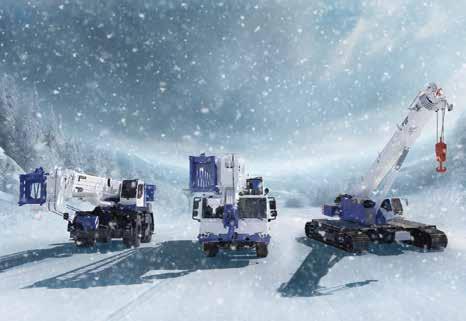



By Dimitra Lavrakas
Tu rbulence in Alaska’s seafood processing industry made headlines in 2024.
Trident Seafoods, the largest employer in the sector, retrenched by offloading properties in Kodiak, Ketchikan, Petersburg, and False Pass, and the company postponed construction of a new megafactory in Unalaska. Peter Pan Seafood Co., a venerable brand for more than a century, folded entirely, going into receivership. Meanwhile, Silver Bay Seafoods is swooping in to expand its Alaska presence.
Underneath the feet of these giants, smaller processors weathered the same turmoil in harvest numbers and market prices. They navigate the storm by a compass that points to quality, sustainability, and investment in coastal communities.
“When fishermen have the opportunity to access a small processor, they are able to retain a higher value for their catch, their catch maintains higher quality, and their connection to consumers strengthens and ensures the sustainability of the system,” says Amanda Wlaysewski of Kvichak Fish Co. in Bristol Bay.
In an increasingly uncertain environment for fish numbers, both the small, local processors and direct-to-customer marketing become key to not only sustainable harvests but also in sus taining communities.
Kvichak Fish Co. was established in 2012 in Naknek as a custom processor where fishermen bring their catch to be cut. Wlaysweski explains, “Eighteen boats, both set net and drift boats, support my
business, along with gill net gear and one long-line boat.”
The longliner uses baited hooks branching from a main line that, on a family-sized boat, might stretch less than 60 feet. (Industrialscale longliners set hundreds of hooks along miles of line.) Mainly targeting groundfish like halibut, the industry is represented by the Sitkabased Alaska Longline Fishermen’s Association (ALFA).
One of ALFA’s programs is Alaskans Own, a not-for-profit community supported fishery. All of its proceeds go back to ALFA for fishery conservation and community health and resilience. Natalie Sattler, program director at ALFA, says, “Alaskans Own has been delivering wild, sustainable Alaska seafood to families throughout Alaska and the United States. Our fishermen are committed to producing the highest quality fish and practicing the most sustainable fishing method.”
Those methods, in addition to longlining, include trolling, drift gillnet, and set gillnet. They are considered sustainable because they bring in fish one at a time; therefore, they incur less bycatch of unwanted species. Alaskans Own pledges that all seafood is hand caught.
Eva’s Wild, a specialty distributor, boasts that its Bristol Bay sockeye salmon has the lowest carbon footprint of any “center of plate” protein. “We are committed to being a business who promises a circular economy, giving back to the source of our food products in Bristol Bay, rather than just taking from it,” says founder and CEO Mark Titus.
Before sharing the world’s richest salmon fishery with the world via the plate, Titus told the story of the resource as a
“When fishermen have the opportunity to access a small processor, they are able to retain a higher value for their catch, their catch maintains higher quality, and their connection to consumers strengthens and ensures the sustainability of the system.”
Amanda Wlaysewski Co-founder and Owner Kvichak Fish Co.
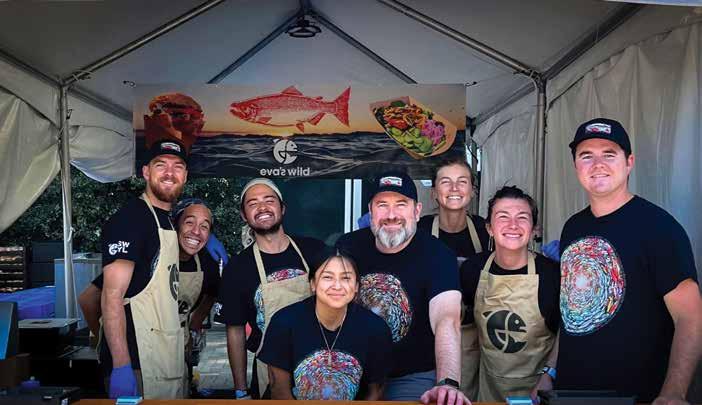
“We are committed to being a business who promises a circular economy, giving back to the source of our food products in Bristol Bay, rather than just taking from it.”
Mark Titus Founder and CEO
Eva’s Wild
documentary filmmaker. “After taking my films The Breach and The Wild to audiences across the United States, I created Eva’s Wild to answer the question I was asked at every Q&A: ‘What can I do to help protect wild salmon for future generations?’ Eating wild salmon from the world’s most sustainable sockeye salmon fishery bolsters the Bristol Bay economy,” says Titus. He adds that Eva’s Wild donates 10 percent of profits to The Bristol Bay Foundation, mainly to support postsecondary education for Bristol Bay’s Indigenous young people.
Plowing profits back into fishing ports is also a priority for Camtu’s Alaska Wild Seafoods in Cordova. The processor works with about 250 drift and set gillnet vessels.
Tu Trinh Dillon’s parents started the business in 2014. “The owners started this business as a fisherman family with great passion and reverence for the seafood industry,” says Dillon, the company’s office and
operations manager. “Understanding the perspective as a fisherman alongside a deep appreciation for the town of Cordova, they established Camtu’s Alaska Wild Seafoods to give back to the community and give more to the fishermen.”
Small, sustainable seafood companies use these methods not just to avoid overfishing but also to handle the harvest gently.
“The proudest component of our business is the owners’ story and their utmost commitment to high quality,” says Dillon. “The quality in their salmon was noticed and revered by customers.”
Camtu Ho and Thai Vu are Vietnamese immigrants and built several successful businesses from the ground up. “Without any prior knowledge or help, Thai took his fishing boat out and taught himself how to fish salmon,” Dillon recalls. “The orders grew large enough
where they had to purchase salmon from other fishermen.” Her parents then had to construct a processing line next to their grocery store to accommodate the growing shipments. Camtu’s Alaska Wild Seafoods now moves up to 6 million pounds of salmon annually.
Another fishing family with an emphasis on quality is Fish & Family Seafoods in Sitka. “I grew up in a fishing family and started spending time on our boat as a youngster,” says Lexi Hackett, who runs Fish & Family Seafoods with her husband, Adam. “As a teenager, I started crewing seasonally. Adam and I bought our first boat, a salmon troller, in 2009. We then upgraded to a freezer troller in 2014, which is also when we started our direct marketing business.”
Hackett admits that trolling is labor intensive, but the resulting catch is top notch. “We consider our catch—frozen at sea, troll-caught, ocean-run salmon—to be very special,” she says. “Freezer trolling is a labor of love, and we want to see our product reach people who appreciate it for its full worth.”
Hackett says one of her business goals is to maximize fish value and crew shares. That raises the price tag, so marketing efforts must sell the consumer on the benefit of small fisheries that co me at a higher cost.
“Many people comment on the relatively high cost of wild Alaska seafood,” Hackett says. “I want readers to know that fishermen put a tremendous amount of work into eac h pound of seafood.”
The premium price pays for a high-quality product and to sustain the entire fishery. Hackett says, “We appreciate every customer
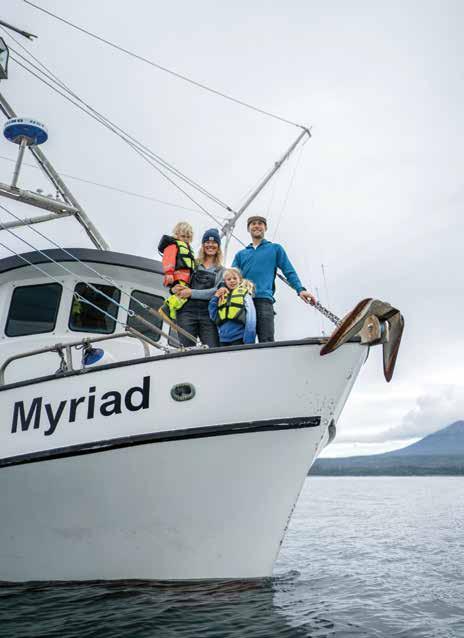

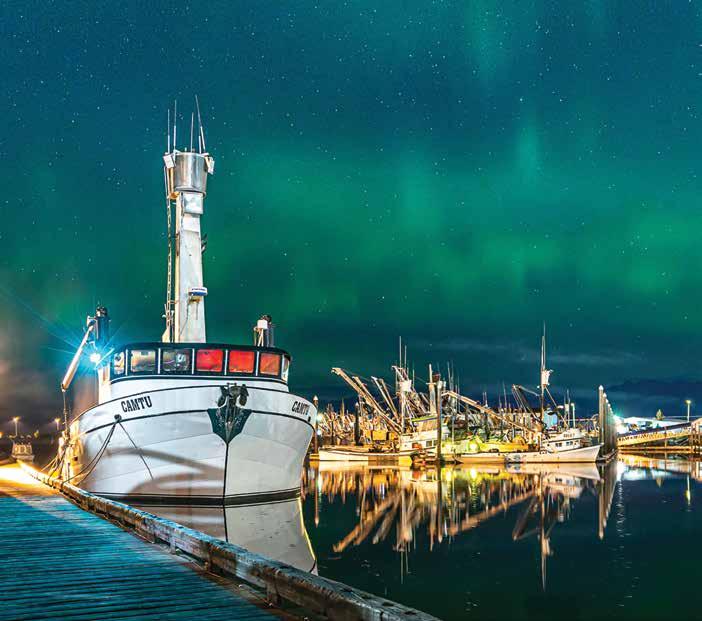
“We consider our catch—frozen at sea, troll-caught, oceanrun salmon—to be very special… Freezer trolling is a labor of love, and we want to see our product reach people who appreciate it for its full worth.”
Lexi Hackett, Co-owner, Fi sh & Family Seafoods
who shops consciously and chooses hook-and-line-caught, w ild Alaska seafood.”
Those conscious shoppers are all over the world.
“We sell both in and outside of Alaska. Anchorage, Fairbanks, Montana, Idaho, Washington, Brooklyn [New York], Oregon, and Wyoming,” says Wlaysewski. She started Kvichak Fish Co. as a custom processor mainly for personal use of
sockeye salmon and Pacific halibut. “Subsistence and ‘homepack,’” she explains. “I had no idea the direct market business would fol low so immediately.”
Direct marketing from Alaskans Own takes the form of a “build your
own” gift box, in which customers can order specialty products harvested from Southeast waters.
Alaskans Own also provides monthly seafood shares featuring a selection of in-season, premium quality, wild Alaska seafood harvested by its community of s mall-boat fishermen.
Sattler explains, “Monthly Seafood Shares are available in our Alaskans Own hubs (Sitka, Juneau, Fairbanks, Anchorage, Seattle, and Bellingham, Washington) and distributed once a month at a predetermined location and time.”
From the Copper River and Prince William Sound fisheries, Camtu’s Alaska Wild Seafoods offers fresh and frozen headed and gutted salmon and green roe from all five species of Pacific salmon. “We sell within Alaska, throughout the United States, and export internationally as well (Europe and A sia),” says Dillon.
Fine restaurants around the United States get Bristol Bay sockeye salmon from Eva’s Wild, which also sells direct to customers’ doors.
Restaurants are also a target for direct marketing from Fish & Family Seafoods for its frozen-at-sea king salmon, coho salmon, black cod/ sablefish, rockfish, and lingcod. “We have our fish in restaurants in Sitka; Seattle, Washington; Portland, Hood River, and Bend, Oregon; and San Francisco and Marin County, Califo rnia,” Hackett says.
For individual consumers, she adds, “We have pick-up locations for our small fish box sales in Bellingham and Seattle; Portland and Bend; Half Moon Bay, California. We also ship via overnight delivery to anywhe re in the Lower 48.”
Hackett notes that direct-toconsumer small fish box sales only include product harvested from her family boat, F/V Myriad . “For our restaurant customers, we have branched out and now buy fish from three to four different boats in total,” she says. “All our partner boats are freezer trollers, just like us. In other words, they catch salmon using hook and line methods,
then hand process each fish and immediately blast freeze them.”
The personal touch is key. “We know who is cooking up our fish, and our customers know who caught it,” says Hackett. “This direct connection motivates us even when fishing is slow and inspires us to process each fish with respect and care. It makes the whole job more fu n and meaningful.”
Through a statewide helpline, investment in education and housing programs, and much more, United Way is helping people in Anchorage and across Alaska.
By Sean Dewalt

Wo rkers’ compensation is a no-fault insurance system that protects workers and employers from financial losses caused by on-the-job accidents and job-related illnesses. In Alaska, coverage is mandatory, not voluntary. Unlike other states, there are no “opt out” provisions under the Alaska Workers’ Compensation Act. This insurance provides employees with medical benefits and compensation for lost wages due to injury, occupational disease, or death arising from their employment.
Companies with more than one employee are required to carry workers’ comp insurance. Under Alaska Statutes Title 23, Chapter 30, an employee is generally defined as, “a person who is not an independent contractor as defined in AS 23.30.230 and who, under a contract of hire, express or implied, is employed by an employer.” Section 230 lists a few exceptions to the workers’ comp requirement (which can include but are not limited to): officers of a nonprofit corporation, parttime babysitters, non-commercial
cleaners, sports officials for amateur events, contract entertainers, and commercial fishermen.
An employer can also elect to self-insure in Alaska. In Alaska, the laws state that an employer must go through a detailed qualification process to obtain a certificate of self-insurance from the Alaska Workers’ Compensation Board. This process requires formal loss control and safety programs, a tangible net worth of at least $10 million, and 100 employees, a mong other criteria.
Typically, employers obtain this coverage from a voluntary market commercial insurance carrier. For various reasons, some employers are unable to obtain workers’ comp insurance in the voluntary market. If a company is working in good faith and is unable to obtain coverage from a commercial carrier, the company may purchase insurance through Alaska's assigned risk pool (commonly referred to as “the pool”), which is administered by the National Council on Compensation Insurance. Companies in the assigned risk pool are there involuntarily; however, the pool offers a solution that allows businesses to legally operate.
There are many reasons why an employer may not be able to acquire workers’ comp insurance from the voluntary market. Some factors include unstable financial status, poor loss experience (previous insurance claims), a new business venture with little or no prior experience, small company size, or the inherently dangerous or hazardous nature of the work performed by the employer. Although the commercial insurance broker is doing all they can to find coverage in the standard market, the risk appetites of insurance companies still prevail, as insurance is, after all, a business.
The assigned risk pool has a few downsides. First, assigned risk pool rates are higher than those in the standard market for the same classification codes and will likely include a 25 percent surcharge, resulting in higher premiums than companies with competitive rates. Second, the company cannot choose its insurance carrier, as a
• Customized export and import market research and market entry services
• Cross-border (FDI) investment facilitation
• Foreign Trade Zone (FTZ) strategies
• Global sourcing of manufacturing inputs and equipment
• Trade finance and logistics advisory
• Foreign visa assistance
• "Alaska's oldest and largest international trade and business association. Since 1987"
• www.akibc.org
• An Export Management Company (EMC) is a company that acts as an outside export department for small and midsized U.S. manufacturers. By representing several similar, but non-competing, U.S. products, an EMC can leverage its expertise to systematically develop overseas distribution channels for several manufacturers. The core value EMCs provide is to develop international business opportunities and allow partner companies to focus on manufacturing and the US market. EMCs can be a great way to expand while facing staffing shortages or a lack of in-house exporting knowledge. (Source: US Department of Commerce)
• We become your export department
• We absorb the risk of doing international business because we become your local customer
• "Alaska's first full-service export management company"
servicing carrier is assigned to the business, which may limit options for businesses accustomed to working with a particular carrier.
Another important consideration is a mandatory, no-cost loss control inspection. Depending on the size of the operation, class of business, experience modification factor, or other requirements, the insurance carrier will notify the insured that an inspection is required, which can be surprising if a business has never experienced this type of survey. The goals of the required visit include risk assessment, loss trend analysis, safety program review, confirmation of operations, and an evaluation of the company’s hazards and controls. The company must comply with the request and complete the inspection promptly to avoid policy cancellation due to non-compliance.
If the loss control consultant finds unmitigated exposures upon inspection, written recommendations are sent to the insured. These recommendations are aimed at reducing risk in the workplace and should be completed in a timely manner. Any items marked “critical,” defined as “exposures of imminent danger of serious loss potential, or continuing losses,” must be addressed and mitigated within a specified time, or the policy may be canceled.
The loss control consultant will also address other discovered exposures and recommend controls that would improve the overall risk and help protect workers.
Another potential pitfall is the requirement of audit compliance. If the assigned carrier determines that an employer is noncompliant


with a policy audit or fails to pay premiums on time, the policy may be canceled. Since the assigned risk pool is the last resort for workers’ comp insurance, the company becomes “bare,” with no insurance in place, and is no longer able to legally operate in Alaska. According to the Alaska Department of Labor and Workforce Development, “employers may be served with a stop-work order if they fail or refuse to insure employees. Continuing to utilize employee labor after service of a stop-work order results in a $1,000 per day penalty for each day of violation.”
If a business is currently in the standard workers’ comp market, the goal is to remain in that market to get the best competitive pricing



and avoid falling into the assigned risk pool. Doing so takes effort, and protecting workers from injury is the main priority. If a company begins to suffer worker injuries or illnesses, it’s time to mitigate risks before the frequency of claims add up. While three $10,000 claims are worse than one $30,000 claim, large or shock losses, especially with uncontrolled exposures, tend to make insurance carriers nervous. Frequency of workers’ comp claims are often more of a red flag than severity in many cases, and having no claims is the best scenario.
Solutions can come in many forms, but it is a good idea to work with your insurance carrier’s loss control consultant to solicit ideas for quality controls that adequately protect workers. This shows a good faith effort to the insurance company,
and an outside-looking-in approach from a professional could discover creative controls that may not have been considered previously. Conversely, failing to act—or, worse yet, choosing to not work with loss control—can distance the insurance carrier from the company and reduce the chances of policy renewal. If the number of losses and lack of controls relative to exposures are great enough, and no insurance carriers wish to write the workers’ comp risk, the assigned risk pool becomes the only available option.
Like many other aspects of business insurance, it is important to work with your commercial insurance broker to understand why a company is in the assigned risk pool and what can be done to improve the situation. An honest discussion of operations can help create a proactive plan that

improves the business’ chances of avoiding the pool altogether.
If the assigned risk pool is the only option available for the business at the time, it is important to create a strategy that makes the business more attractive to the insurance carriers’ underwriters over time. It may not be as difficult as imagined.
Sean Dewalt is a Senior Loss Control Consultant for Umialik Insurance Company in Anchorage. Dewalt has been working in safety and risk management in Alaska since 2000. This column is intended to be informational and is not intended to be construed as legal advice.





Peter Pan Seafood Co. processing plants in Dillingham and Port Moller are coming under the control of Silver Bay Seafoods. Although former Peter Pan coowner Rodger May outbid Silver Bay at a receivership auction in September, May agreed in November to sell the facilities to Silver Bay, which operated them last season after Peter Pan’s financial collapse. Silver Bay previously bought Peter Pan’s Valdez plant and acquired Trident Seafoods' plants in Ketch ikan and False Pass. silverbayseafoods.com
Hilcorp acquired two nearoffshore units developed by Italian energy company Eni SpA. The companies completed the $1 billion deal for Oooguruk and Nikaitchuq on November 4. The company says a polymer flooding technology that has enhanced oil recovery at the neighboring Milne Point unit could be applied to Eni’s two mature fields. hilcorp.com
With a natural gas shortage looming in Southcentral three winters from now, Furie Operating Alaska committed with Enstar Natural Gas Company to increase Cook Inlet output. A five-year contract is set to begin in 2026, starting at 3 billion cubic feet annually and peaking at 9.5 billion cubic feet, or about one quarter of Enstar’s annual gas demand. Furie’s Chief Commercial Officer Mark Slaughter says additional drilling in the Kitchen Lights Unit would be needed, so the company requested a reduction in state royalties, from 12.5 p ercent to 3 percent.
A subsidiary of Chugach Alaska, the Native corporation for the Prince William Sound region, acquired two mechanical contractors. Chugach Commercial Holdings adds HVAC, LLC and Alaska Integrated Services (AIS) to its portfolio. Founded in Fairbanks in 1995, HVAC performs sheet metal fabrication and heating, ventilation, and air conditioning services. AIS, with offices in Fairbanks and Anchorage, was founded more than twenty years ago. It offers comprehensive HVAC, lighting, security, and automation controls.
commercial.chugach.com
The village corporation for Utqiaġvik acquired a majority interest in Delta Solutions and Strategies, a Colorado-based defense and space services contractor. Delta joins Ukpeaġvik Iñupiat Corporation (UIC) as part of the Bowhead Family of Companies within the UIC Government Services division. The acquisition is UIC’s largest to date. uicalaska.com
A subsidiary of the Alaska Native corporation for the Bering Sea and Aleutian Islands region launched its own real estate brokerage. Headquartered in Anchorage, Tayal Brokerage is led by broker-incharge Mike Jenks, a shareholder of Aleut and The Atxam Corporation, the village corporation for Atka Island. Jenks also serves as general manager of Aleut Real Estate (ARE), the regional corporation’s property investment and management arm. Under ARE, Tayal Brokerage offers consulting and investment strategy, serving clients across Alaska with a particular focus on the Anchorage area and Matanuska-Susitna
Borough. The name “Tayal” means “to buy” in Unangam Tunuu. aleutcorp.com
Retooling under a model called “full agent support,” RMG Real Estate Network shifted away from the Keller Williams brand and started its own brokerage. Founder Reed Moore says his team of almost forty agents, moving almost 500 units per year, is big enough that he was practically already providing brokerage services such as listing and transaction management, marketing, and bookkeeping. To promote good professional habits, RMG is setting up a flexible commission structure while offering coaching and consistent training. rmgrealestate.com
Northrim BanCorp, parent of Anchorage-based Northrim Bank, purchased a Texas firm that provides factoring, asset based lending, and alternative working capital solutions to small and medium sized enterprises. As a wholly owned subsidiary, Sallyport Commercial Finance complements Northrim Funding Services, a factoring division of Northrim Bank. Northrim expects the $53.9 million cash purchase to yield earnings accretion of approximately 15 percent to 2025 operating results. northrim.com
Two factors led Heather Kelly to make the difficult decision to relocate her Heather’s Choice food company out of Anchorage. As she explained in a followup appearance on the TV show Shark Tank in December, making and selling dehydrated snacks and meals is logistically harder












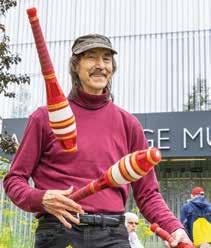

in Alaska, especially as sales have grown. Secondly, she visited Oregon two years ago and fell in love with the place. Several company staff agreed to relocate as well. heatherschoice.com
Cable TV is going away for GCI subscribers by the middle of 2025. The telecom company notified customers in November that its television service will sunset, given the migration toward internet
streaming. The company has been in the TV business since 1996 when it leveraged its position as a homegrown long-distance telephone company to buy out Alaska Cablevision, Alaskan Cable Network, and Prime Cable of Alaska for $280.7 million, absorbing their combined 101,000 subscribers. gci.com
Before a pipeline can monetize stranded North Slope natural gas,
Texas-based TA Infrastructure is advancing a wilder approach using cryptocurrency. The company applied for a state permit to install a data center (the size of a shipping container) at Hilcorp’s Endicott field. The pilot project would turn gas into electricity, electricity into computing cycles, and computing cycles into Bitcoin, which can be traded for real money. Plus, the chilly Arctic Ocean site minimizes power lost to cooling the computer hardware.

The corner of the market for snowboard deck treads is in eastern Fairbanks. Skaters on streets, snow, and surf worldwide use black or yellow peel-and-stick tabs made by one of their own.
Joshua Poe manufactures Tundra Grip, sheets of polyurea plastic
sprayed onto molds designed with conical knobs for optimal traction, in his scratch-built asse mbly line.
The material of choice for Poe's shreddin' brethren also improves the safety of stairs and steps at homes or industrial sites. "This grip tape is the perfect solution
for skating the rawness of Alaska," he says.
Part 27 of an ongoing video series.
Scan the QR code to watch the video featuring GripAll Traction Products. youtube.com/@alaskabusinessmagazine











· One of Alaska’s largest full-service mechanical contractors has a new General Manager. Sheet Metal Inc. promoted Robert Reid, who has been serving as business development manager. Reid has been with the company for more than six years, playing a pivotal role in expanding Sheet Metal Inc.'s market presence and fostering key client relationships. Reid brings more than eighteen years of experience in the commercial HVAC industry, making him an asset in driving the company's growth in HVAC, plumbing, fabrication, and service focused solutions.
Credit Union 1

· Credit Union 1 appointed Tina Narron as its new Chief Lending Officer, overseeing all aspects of lending operations, including strategy development, portfolio management, and member engagement. Narron held the same position at her previous employer, Verity Credit Union in Seattle, and at Providence Federal Credit Union in Portland, Oregon before that. Narron’s financial career
began at BECU, where she worked as a consumer lending manager, and later at GTE Financial as VP consumer loans. Narron’s involvement in various advisory and nonprofit boards has focused on supporting underserved communities, including women business owners, advocating for affordable housing, and assisting individuals experiencing homelessness.
· The Alaska office of National Cooperative Bank added Daryl Lowe as Vice President, Corporate Banking, responsible for expanding business lending and deposit opportunities in the Alaska market, especially with Native corporations. With twenty-nine years of experience in banking, Lowe was previously a senior commercial loan officer with McKinley Alaska Growth Capital. He has a bachelor’s degree in business administration with a focus on management from the University of Alaska.

· The law firm of Holland & Hart added Jim Shine, an experienced Alaska project development attorney, to its Anchorage office
as Of Counsel, enhancing the team guiding clients through regulatory and environmental review for permitting on state and federal lands. From his experience working in the Alaska Department of Natural Resources, with oversight over mining and oil and gas development, Shine has in-depth knowledge of how decisions are made. His professional background with Hilcorp Alaska allows him to understand how companies evaluate investment and development opportunities. Shine also has extensive experience working with local governments and Alaska Native Corporations, and he serves as a board member of the Resource Development Council for Alaska.
Alaska Heart & Vascular Institute

· Cardiologist Dr. Josiah Brown, specializing in minimally invasive therapies, is the newest team member at Alaska Heart & Vascular Institute (AHVI). Brown is in a position to expand AHVI’s structural heart program, providing new and innovative treatments for patients with previously untreatable conditions. Brown brings expertise in advanced procedures, including transcatheter aortic valve


replacement, mitral valve repair, and left atrial appendage occlusion. Brown completed his medical degree at Oregon Health & Science University and pursued his internal medicine residency at the University of Washington. He then specialized further through general and interventional cardiology fellowships at the Cedars-Sinai Smidt Heart Institute in Los Angeles. He helped research a novel cardiac injury biomarker sensor.

· Juneau-based alliance for mental health JAMHI Health and Wellness chose Will Jemison as CEO. Jemison comes to Alaska from Arkansas, where he most recently served as chief of staff to the CEO of the new Alice L. Walton School of Medicine, which opened in September. Jemison holds a doctorate in healthcare administration from Virginia University of Lynchburg. He completed his undergrad and MBA studies at Louisiana State University. “I am thrilled to join the JAMHI team,” says Jemison. “I welcome the opportunity to listen, learn, and serve the people of the greater Juneau community.”
· The Railbelt Reliability Council (RRC), an organization formed in 2022 to coordinate operations, planning, and cooperation among the state’s grid-

connected electric utilities, hired Edward Jenkin, an executive from Matanuska Electric Association (MEA), as its new President and CEO. His duties include transitioning RRC from the organizational development stage to performing its primary mission work. For the past year, Jenkin served as MEA’s chief energy transformation officer, promoted to that role after serving as COO. Prior to joining MEA in 2014, Jenkin spent twenty-five years at Chugach Electric Association, including a stint as vice president of power delivery. Jenkin was chosen after an extensive international search. According to the RRC board of directors, Jenkin is recognized for his expertise, reputation of integrity, and consistent leadership.

· Homer-based infant and early learning nonprofit Sprout Family Services selected Jonathan McGhee as its Executive Director. McGhee has been serving at South Peninsula Behavioral Health Services since 2017, most recently managing the adult rehab program and training for individual placement and support. He led another nonprofit in the Philippines, and he was executive director of Resources for the Blind
International, where he developed an early intervention preschool for visually impaired children.

· The Food Bank of Alaska hired Daniel A. Bentle as Chief Philanthropy Officer to lead fundraising, marketing, and volunteer programs. Bentle’s background in community and economic development, agriculture, and education aligns with the organization’s values-driven approach, further enhancing Food Bank of Alaska’s mission to combat food insecurity. His passion for relationship building and impactful partnerships will strengthen the organization’s network of support as it enters a new phase of growth under CEO Cara Durr. Bentle earned a bachelor’s degree in business administration from Spring Arbor University in Michigan, also earning a semester at the University of Oxford in England to study political philosophy and Renaissance literature. He completed his MBA at Washington University in St. Louis, where he became the director of the Center for Experiential Learning at the Olin Business School. He previously worked as a global marketing consultant, and his most recent position was as vice president of sales with N2Growth, an executive search and organizational leadership firm.














Fi re: man’s oldest foe. Insatiable. Remorseless. Unquenchable—except with firefighting apparatus, whether high-tech or as simple a s a bucket of water.
Fire protection 101: snuff a flame by depriving it of heat, fuel, or oxygen. For advanced studies, this month’s article “Making It Rain” by Rachael Kvapil consults with engineers who know the best way to fight a fire is to prevent it from starting in the first place. In the Hierarchy of Hazard Controls, engineers first seek to eliminate potential fuel sources, or substitute less flammable materials. The next tool is designing the environment to minimize fire risk, such as physically separating heat sources from fuels. Administrative controls, such as safety rules and operational procedures, are next on the hierarchy, and the last resort is the most visible: personal protective equipment, including wall-mounted extinguishers. Astute scholars will notice that several steps in the hierarchy precede systems such as sprinklers, alarms, barr iers, and detectors.
Fun fact about smoke detectors: the ionization type contains two of the most exotic chemical elements in the average home. A tiny amount of americium, about the size of a snowflake’s arm, expels ionized particles as it decays into neptunium. The total world supply of americium could fit in a suitcase; the isotope sells for about $43,000 per ounce, but only a few pennies’ worth is in a smoke detector. Thus, engineers harness one of the newest elements known to humanity in the battle aga inst the oldest foe.
Consider this edition of Alaska Trends to be a crash course in the most basic lessons in fire prote ction engineering.

Thermographic cameras detect temperature differences on surfaces and identify abnormal heating, which could indicate an incipient fire.
Aspirating smoke detectors detect micro particles of smoke. Traditional smoke detectors could be ionization or photoelectric types. Flame detectors identify ultraviolet and infrared radiation emitted by flame. Sprinklers are activated by heat. The flames melt a cap releasing the water.


Ionization smoke detectors contain an ionization chamber with a small amount of radioactive material which ionizes the air in the chamber. When a fire occurs, smoke particles enter the ionization chamber, neutralizing the ions in the air, reducing the current, and triggering the alarm.
Ionization smoke detectors are more sensitive to smoke produced by flaming fires, such as those caused by burning paper or wood.


Photoelectric smoke detectors contain an optical chamber with a light source and a photosensitive resistor. When a fire occurs, smoke particles enter the optical chamber, scattering or reflecting the light, causing some of it to hit the photosensitive resistor and triggering the alarm.
Photoelectric smoke detectors are more sensitive to smoke produced by smoldering fires, such as those caused by burning electronics or plastics.

What book is currently on your nightstand?
Good to Great: Why Some Companies Make the Leap… and Others Don’t by Jim Collins. Daring Greatly: How the Courage to Be Vulnerable Transforms the Way We Live, Love, Parent and Lead by Brené Brown is another one.
Dead or alive, who would you like to see perform in concert? George Strait.
If you could domesticate a wild animal, what animal would it be?
A baby dragon.
What’s the first thing you do when you get home after a long day at work?
Kiss my wife and give her a hug. And say hi to the kids.
What are you superstitious about?
Um… I’m trying to think about what I do superstitiously. [His wife, Megan, suggests: “You always sit with your back toward the wall, Louis L’Amour style.”] Well, I gotta be facing the entrance!

by
Forty years ago, the inaugural list of
The New 49ers (as this magazine then called the highest-earning Alaskan-owned companies) included Debenham Electrical Supply at #27. Owning and operating its shops and warehouses paved the company’s transition from wholesaling into real estate. Now Shaun Debenham runs the sequel to his father’s company as a general contractor, property manager, and building developer.
“I definitely have a passion for structures and buildings, creating an environment that betters the city, betters the people and the landscape,” he says.
Debenham earned degrees in real estate development and structural engineering from the Massachusetts Institute of Technology and brought that know-how back to Alaska to construct badly needed multifamily housing. He also feels fortunate to have a friend in Dean Weidner, the Seattle-based magnate whose Alaska holdings span more than 4,000 apartment units. Debenham credits the growth in his business partly to Weidner’s mentorship.
“It’s something he didn’t need to do,” Debenham says, “but he’s got a nostalgia for Alaska.”
Alaska Business: What do you do in your free time?
Shaun Debenham: I do a lot of road biking. Hiking and camping with the family.
AB: Is there a skill you’re currently developing or have always wanted to learn?
Debenham: Probably woodworking. I’m OK with it, but I never really had the time to develop it.
AB: What charity or cause are you passionate about?
Debenham: I’m passionate about helping the youth of our city. It’s difficult for them nowadays, so anything I can do to help them is important to me.
AB: What’s the most daring thing you’ve ever done?
Debenham: Oh, man. Probably bungee jumping in New Zealand off a 300-foot bridge.
AB: What vacation spot is on your bucket list?
Debenham: Italy
AB: What’s your gr Debenham: I just bought a truck. I love my truck. It’s awesome! It’s incredible: Chevy Silverado Trail Boss. So it’s got a lift in it. It’s kind of my dream truck.
AB: What’s your favorite local restaurant?
Debenham: Tommy’s Burger Stop.
AB: What’s your best attribute and worst attribute?
Debenham: I’m pretty organized; I can make complicated things simple. Worst attribute? Hmm. There’s just too many! Taking on too much, probably. More than I can do.

2 Mobius Technology Solutions, Inc 75 2mobius.com
3-Tier Alaska 59 3tieralaska.com
Airport Equipment Rentals 111 airportequipmentrentals.com/
Alaska Dreams Inc 99 alaskadreamsinc.com
Alaska International Business Center 97 alaskadreamsinc.com
Alaska Mergers & Acquisitions, LLC 87 alaskadreamsinc.com
Alaska Pacific University 85 akibc.org
Alaska Railroad 75 alaskadreamsinc.com
Anchorage Convention Centers 29 anchorageconventioncenters.com
Anchorage Sand & Gravel 63 anchsand.com
Arctic Encounter 7 arcticencounter.com
Bettisworth North 3 bettisworthnorth.com
Birch Horton Bittner & Cherot 98 bhb.com
Chugach Alaska Corporation 43 chugach.com
Coffman Engineers 41 coffman.com
Conrad-Houston Insurance Agency 89 chialaska.com
Construction Machinery Industrial 2 cmiak.com
Cook Inlet Tug & Barge Inc 45 cookinlettug.com
Craig Taylor Equipment 55 craigtaylorequipment.com
Design Alaska 89 designalaska.com
Equipment Source, Inc 65 esialaska.com
First National Bank Alaska 5 fnbalaska.com
Fountainhead Development 21 fountainheadhotels.com
Global Credit Union 13 globalcu.org
Hotel Captain Cook 31 captaincook.com
IMA Financial Group 9 imacorp.com
JAG Alaska 77 jagalaska.com
Kinross Alaska 25 kinross.com
Lennon Crane and Equipment Company 89 lennoncrane.com
Lynden 112 lynden.com
Manley Brautigam Bankston P.C 81 mb-lawyers.com
Material Flow & Conveyor Systems, Inc. 49 materialflow.com
Michael Baker International.. 79 mbakerintl.com
Nana Regional Corporation.. 27 nana.comt
Nenana Heating Services, Inc 87 nenanaheatingservicesinc.com
nortechengr.com
nac.aero
oxfordmetals.com
peopleak.com


















At




